Please use a modern browser to view this website. Some elements might not work as expected when using Internet Explorer.
- Landing Page
- Luxury Yacht Vacation Types
- Corporate Yacht Charter
- Tailor Made Vacations
- Luxury Exploration Vacations
- View All 3600
- Motor Yachts
- Sailing Yachts
- Classic Yachts
- Catamaran Yachts
- Filter By Destination
- More Filters
- Latest Reviews
- Charter Special Offers
- Destination Guides
- Inspiration & Features
- Mediterranean Charter Yachts
- France Charter Yachts
- Italy Charter Yachts
- Croatia Charter Yachts
- Greece Charter Yachts
- Turkey Charter Yachts
- Bahamas Charter Yachts
- Caribbean Charter Yachts
- Australia Charter Yachts
- Thailand Charter Yachts
- Dubai Charter Yachts
- Destination News
- New To Fleet
- Charter Fleet Updates
- Special Offers
- Industry News
- Yacht Shows
- Corporate Charter
- Finding a Yacht Broker
- Charter Preferences
- Questions & Answers
- Add my yacht
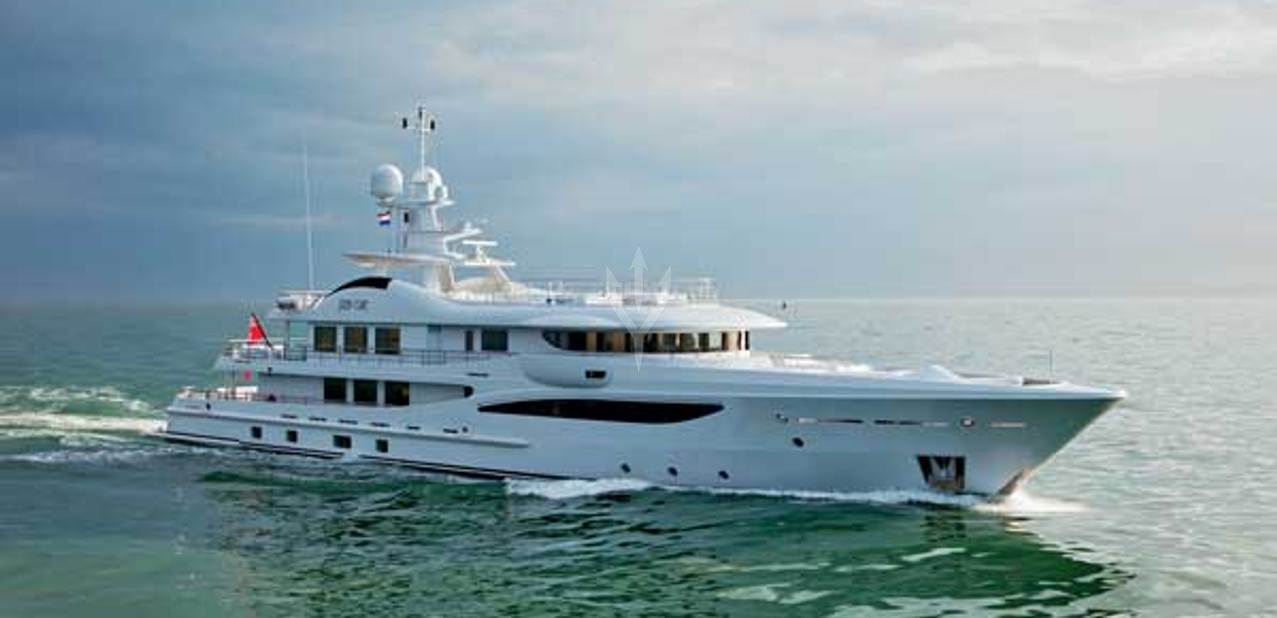
Private YACHT
NOT FOR CHARTER*
SIMILAR YACHTS FOR CHARTER
VIEW SIMILAR YACHTS
Or View All luxury yachts for charter
- Luxury Charter Yachts
- Motor Yachts for Charter
- Amenities & Toys

STEP ONE yacht NOT for charter*
55m / 180'5 | amels | 2012 / 2015.
Owner & Guests
Cabin Configuration
- 1 Double/Twin
- Previous Yacht
Special Features:
- Huge split-level sundeck
- Steam room in beach club
- Clean, modern and fun interior
- Piano bar in skylounge
- Versatile five-cabin layout
The 55m/180'5" motor yacht 'Step One' was built by Amels in the Netherlands at their Vissingen shipyard. Her interior is styled by Italian designer design house Laura Sessa Romboli and she was delivered to her owner in May 2012. This luxury vessel's exterior design is the work of Tim Heywood Design and she was last refitted in 2015.
Guest Accommodation
Step One has been designed to comfortably accommodate up to 10 guests in 5 suites comprising two VIP cabins and one cabin that can operate as twin or double. She is also capable of carrying up to 13 crew onboard to ensure a relaxed luxury yacht experience.
Onboard Comfort & Entertainment
Her features include steam room, beach club, deck jacuzzi, WiFi and air conditioning.
Range & Performance
Step One is built with a steel hull and aluminium superstructure, with teak decks. Powered by twin diesel MTU (16V 2000 M70) 16-cylinder 1,408hp engines running at 2100rpm, she comfortably cruises at 13 knots, reaches a maximum speed of 15 knots with a range of up to 4,500 nautical miles from her 115,000 litre fuel tanks at 13 knots. Her water tanks store around 17,000 Litres of fresh water. She was built to Lloyds Register classification society rules.
PRIVATE YACHT - "Step One" IS NOT FOR CHARTER
Sorry, motor yacht "Step One" is a strictly Private yacht and is NOT available for Charter. Click here to view similar yachts for charter , or contact your Yacht Charter Broker for information about renting another luxury charter yacht.
"Yacht Charter Fleet" is a free information service, if your vessel changes its status, and does become available for charter, please contact us with details and photos and we will update our records.
Step One Photos
Step One Awards & Nominations
- The World Superyacht Awards 2013 Best Displacement Motor Yacht of 500GT to 1,299GT (approximately 50m – 59m) Finalist
- Asia Boating Award 2013 Best Semi Custom Built Yacht (30m and up) Finalist
NOTE to U.S. Customs & Border Protection
NOTE TO U.S. CUSTOMS & BORDER PROTECTION
Due to the international and fluid nature of the yachting business and the fact there is no global central industry listing service to which all charter yachts subscribe it is impossible to ascertain a truly up-to-date view of the market. We are a news and information service and not always informed when yachts leave the charter market, or when they are recently sold and renamed it is not clear if they are still for charter. Whilst we use our best endeavors to maintain accurate information, the existence of a listing on this website should in no way supersede official documentation supplied by representatives of a yacht.
Specification
M/Y Step One
SIMILAR LUXURY YACHTS FOR CHARTER
Here are a selection of superyachts which are similar to Step One yacht which are believed to be available for charter. To view all similar luxury charter yachts click on the button below.
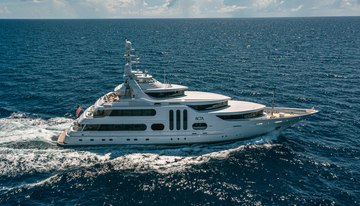
51m | Feadship
from $195,000 p/week
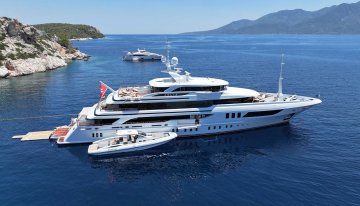
56m | Benetti
from $363,000 p/week ♦︎
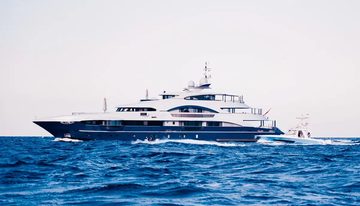
55m | Heesen
from $350,000 p/week
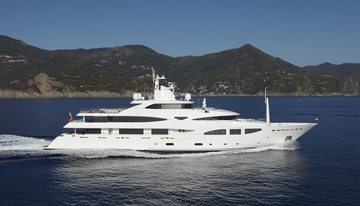
from $374,000 p/week ♦︎
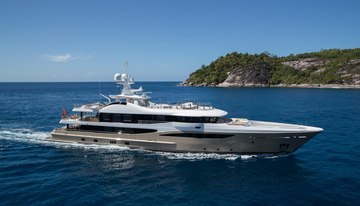
55m | Amels
from $295,000 p/week

59m | Benetti
from $395,000 p/week
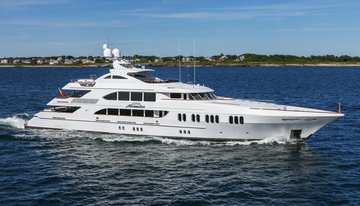
Aspen Alternative
50m | Trinity Yachts
from $199,000 p/week
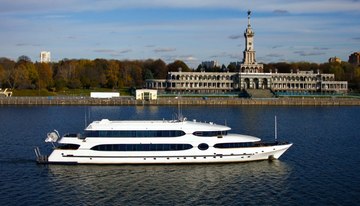
49m | Custom
POA ♦︎

58m | Turquoise Yachts
from $344,000 p/week ♦︎ *

50m | Cantieri Navali di Termoli
from $224,000 p/week ♦︎
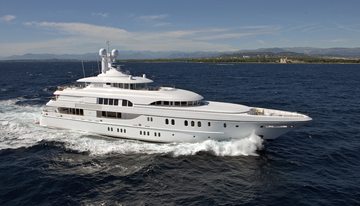
60m | Lurssen
from $550,000 p/week
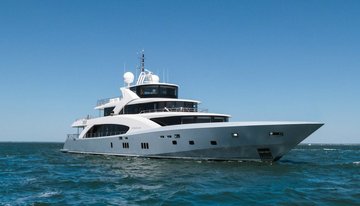
50m | Couach
from $217,000 p/week ♦︎
As Featured In
The YachtCharterFleet Difference
YachtCharterFleet makes it easy to find the yacht charter vacation that is right for you. We combine thousands of yacht listings with local destination information, sample itineraries and experiences to deliver the world's most comprehensive yacht charter website.
San Francisco
- Like us on Facebook
- Follow us on Twitter
- Follow us on Instagram
- Find us on LinkedIn
- Add My Yacht
- Affiliates & Partners
Popular Destinations & Events
- St Tropez Yacht Charter
- Monaco Yacht Charter
- St Barts Yacht Charter
- Greece Yacht Charter
- Mykonos Yacht Charter
- Caribbean Yacht Charter
Featured Charter Yachts
- Maltese Falcon Yacht Charter
- Wheels Yacht Charter
- Victorious Yacht Charter
- Andrea Yacht Charter
- Titania Yacht Charter
- Ahpo Yacht Charter
Receive our latest offers, trends and stories direct to your inbox.
Please enter a valid e-mail.
Thanks for subscribing.
Search for Yachts, Destinations, Events, News... everything related to Luxury Yachts for Charter.
Yachts in your shortlist

More About STEP ONE
STEP ONE Yacht
Motoryacht step one.
The STEP ONE yacht is a 180.4ft / 55m luxury yacht built and launched by yacht builder Amels . Delivered to a proud yacht owner in 2012 and refit in 2020, this luxury yacht sleeps up to 12 guests in 5 staterooms and has accommodations for 16 crew. She has a beam of 29.5ft / 9m, a draft of 11.2ft / 3.4m, and she measures in at 672 gross tons. Her hull is steel and her decks are teak. Her max speed is 15.5 knots and cruising speed is 13 knots. She is propelled by MTU engines at 1,408 hp each. Her interior design is by Laura Sessa Romboli with exterior styling by Tim Heywood .

Download PDF Brochure

Download PDF Brochure ,
- Specifications
Page Contents
- STEP ONE yacht location
- Yachts for sale
Contact: Merle Wood & Associates | web(Contact us at)merlewood.com | +1.954.525.5111
* Not offered for sale or charter to U.S. residents while in U.S. waters unless under a boat show bond or in an FTZ.
Related Yacht Ownership | Why Buy A Yacht | How To Buy A Yacht | Build Your Own Yacht
STEP ONE Yacht Photos
View the photo gallery page to browse all the STEP ONE yacht photos , including interior and exterior images.
STEP ONE Yacht Video
View the STEP ONE yacht video . ,
STEP ONE Yacht Price & Rate
Eur usd gbp sar cny brl chf rub aud.
select a currency

ASKING PRICE
Send Enquiry
CHARTER RATE
When it comes to purchasing a luxury yacht, like the yachts themselves, pricing may vary greatly. In the event there is no STEP ONE yacht price , the industry knowledge of Merle Wood & Associates will help you with everything you need to know in order to make the right decisions when buying a luxury yacht. If you’d like to know the availability of the STEP ONE yacht for charter and the weekly rate, view the STEP ONE yacht charter price and summary .
STEP ONE Amenities & Features
Water Sports & Tenders
Features & Entertainment
For a complete list of amenities available or for a first-hand review of the STEP ONE yacht, simply request assistance from our qualified luxury yacht brokers. Our team of yacht specialists travel the world visiting and experiencing yachts for sale and not for sale. Because of this, they have expert knowledge about every yacht, and can provide further details about the features, amenities and condition of the most notable yachts on the water.
STEP ONE Yacht Specifications
More details.
We provide accurate specifications, details and current information on yachts for sale around the world. Read the detailed STEP ONE yacht specs and analysis.
STEP ONE Yacht Location
In the South of France
Read more about the cruising grounds, winter or summer itinerary and the last known STEP ONE yacht location .
STEP ONE Yacht Enquiry
For more information or to enquire about the STEP ONE luxury yacht, simply contact a qualified yacht broker at Merle Wood & Associates for assistance.
- 1-954-525-5111
- web(Contact us at)merlewood.com
- About us
I'm interested in:
Chartering a yacht Buying a yacht Selling a yacht Charter marketing Building a yacht Other
Please leave this field empty.
More Yachts For Sale & For Charter
Luxury Yachts
The STEP ONE has been displayed to provide our visitors the most current and accurate data for this luxury yacht. If you would like to report an error or have additional information, including photos and video, related to the STEP ONE, please contact our luxury yacht intelligence team .
At Merle Wood & Associates, we focus on providing the best user experience throughout our website for our visitors. We achieve this by using cookies, which store a little information from your browser. If you would like to learn more, please see our privacy and cookies policy .
Share this page

- Yacht Search
- Charter a Yacht
- Buy A Yacht
- Build a Yacht
- Sell a Yacht

Your Name (required)
Your Message
Please call me Please email me
Your Phone (required)
CANCEL Please leave this field empty.
Asking Price
$33,700,000
A Step above the rest
One of Amels’ highly successful 180 Limited Editions, 55 metre Step One was built on a proven hull and engineering platform with Northern European pedigree. Her extended split-level sundeck is one of the largest on the water for a yacht of this size, offering shaded dining, bar, BBQ, sunbathing spaces and a Jacuzzi. A touch and go helipad enhances the possibilities for exploration. Add to that her impressive beach club with large swim platform, spacious toy garage, steam room and modern, airy interiors and it’s clear the space on board is striking. Used only privately and fresh from a 2.5 million USD refit, including a full paint job, plus recently completing her 10-year survey, Step One is ready to go.
Not for sale or charter to U.S. residents while in U.S. waters
Standout Features
This is Step One

Spacious Elegance
Step One's expansive design, from sun deck to master suite, feels larger than its 55m size.
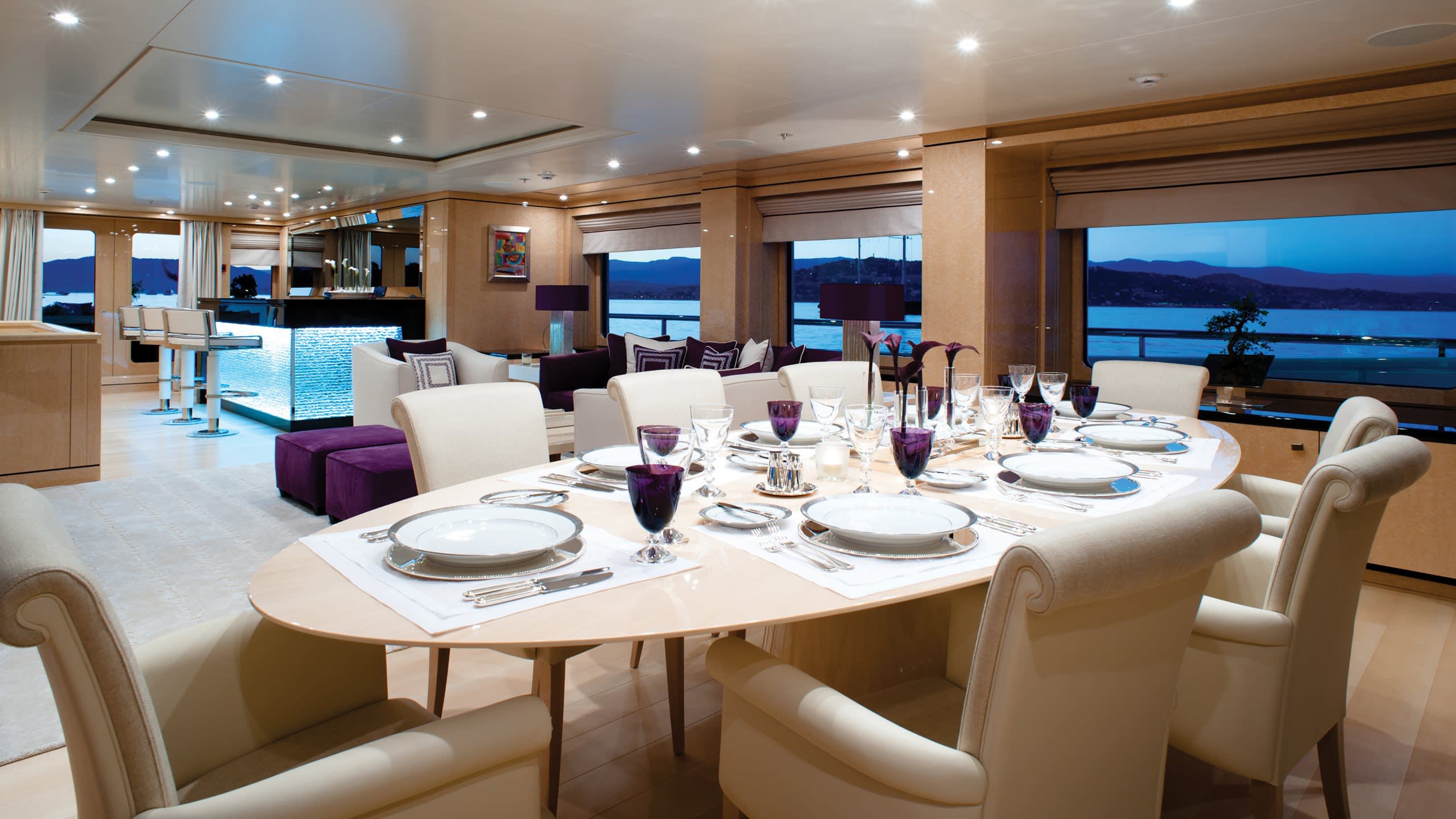
Sophisticated Yacht Interior
Laura Sessa crafted Step One's interior with vibrant accents, ample natural light, and chic sophistication.

Luxurious Deck Spaces
Step One boasts expansive deck areas, surpassing most yachts, with a 155 sqm sun deck.
Yacht Video
Take a tour on board.
Media Gallery
Step One Through The Lens
Chic. Sophisticated. Spacious.
Impressive Spaces
Impressive spaces define Step One, from the huge sun deck to the large swim platform in the beach club, not to mention the full beam master suite and not one, but two open plan salons. Step One feels bigger than her 55m.
Light and Bright
Designed by Laura Sessa, Step One’s interior features accents of colour and is abundant in natural light thanks to large windows which frame the views outside. Chic and sophisticated, the contemporary design enhances the feeling of space and brightness which characterizes the yacht’s interior.
Standout Decks
Standout deck spaces are Step One’s super power. Her split-level sun deck is larger than most yachts of this size, at 155 square metres, and includes a Jacuzzi, bar, BBQ and sunbathing and dining area while the beach club allows easy access to the water. Put simply, Step One is designed for relaxation and entertainment.

Accommodation
Sun. Sea. Sleep. Repeat
Cabin arrangement.

Owner's Suite
On the main deck, a full beam Owner's suite with office, walk-in wardrobe and a large ensuite bathroom.

Option: Four Cabins
The lower deck cabins can be configured as four double cabins to allow privacy and comfort for multiple couples.

Option: Two Doubles and a VIP Suite
Alternatively, two of the lower cabins can be configured as a full-beam VIP suite with a private lounge area.

Performance
Proven Platform. Ready for Adventure.
Northern European Pedigree
As part of the Limited Editions Amels 180 series, the yacht comes with the peace of mind her Dutch pedigree warrants. With proven engineering and seaworthiness even the most rugged explorer yacht would be proud of, Step One can go the distance and look great while doing it.
Up To Date and Ready To Go
Having only ever been used privately and benefiting from a rigorous maintenance schedule, Step One is in excellent condition and is up to date following her 10-year survey plus she is fresh from a full paint job among a host of other maintenance investment.
Extended Exploration
Thanks to a touch and go helipad above the wheelhouse, you can go even further in your explorations. The potential for discovery is effectively limitless.
More Yachts Like Step One
Seagull MRD
Benetti SpA
Brodosplit Inc.
Hospitality
Westport Yachts
Overmarine Group SPA
Amore Mio 2
Abeking & Rasmussen
Your Privacy
We use cookies to enhance your browsing experience, analyse our traffic and assist in personalised marketing. By selecting “Allow Cookies”, you consent to our use of cookies.
LET'S CHAT.
Get in touch with one of our teams around the world.
Where you'll find us
Monaco — MC
London — UK
Fort Lauderdale — US
Auckland — NZ
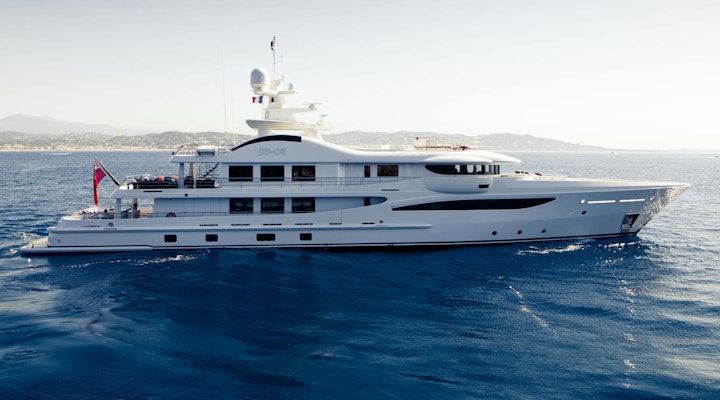
STEP ONE Specifications
Completed amels yacht step one.
Built by the innovative AMELS yard and delivered in 2012, STEP ONE is the first AMELS 180 from the successful Limited Editions range.
Dutch luxury builder AMELS bridges the gap between semi-custom and fully custom yachts with the Limited Editions concept. Tim Heywood, the famed British designer, is responsible for the 55-metre superyacht’s sleek exterior styling with Laura Sessa designing her complete custom interior spaces. STEP ONE boasts a helipad, large sundeck, great interior volumes, and five suites to accommodate eleven guests.
Moran Yacht & Ship negotiated the build contract for STEP ONE, wrote the technical specifications and managed the entire build process for the vessel. Our team was by the owner’s side from concept well through completion.
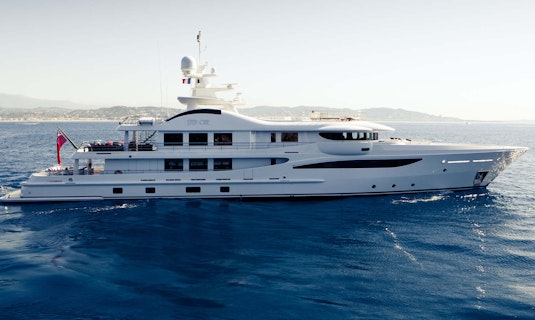
STEP ONE Image Gallery

Enquire about STEP ONE

STEP ONE yacht For sale

Motor YACHT STEP ONE
The STEP ONE yacht is a 180' 6" (55m) luxury yacht, launched and delivered to her original owner by the leading yacht builder AMELS yachts in 2012, and refit in 2015 .
The brilliantly appointed interior accommodations has a 5 stateroom layout, which accommodates 12 guests, and crew accommodations for up to 14 crew.
Her hull is made of steel, and decks finished in teak, with a beam of 29' 7" (9m), measuring in at a total of 672 gross tons.
The Motor Yacht STEP ONE is currently located in Catalonia, with an asking price of $33,700,000
Arrangements for your private viewing (virtual or in-person) can be made by using the contact form below. For an immediate response, simply complete the form and an FGI Yacht Group yacht broker will contact you. (scroll down for a full tour below)
SPECIFICATIONS
Contact us about step one yacht, would you like us to call you back.
Your Name Your phone number Best time to call


Find anything, super fast.
- Destinations
- Documentaries
Motor Yacht
Step One is a custom motor yacht launched in 2012 by Amels in Vlissingen , Netherlands.
AMELS are masters in the art of modern Dutch high-value yacht building. The yard is the largest superyacht facility in the Netherlands and one of the top superyacht builders in the world. In 2005 AMELS launched the successful LIMITED EDITIONS and delivered the first yacht of the series in 2007. The shipyard also specialises in the build of full-custom superyachts, with the in-construction Project Signature due to become the largest superyacht ever built in the Netherlands upon her scheduled launch in 2025.
Step One measures 55.00 metres in length, with a max draft of 3.50 feet and a beam of 9.00 feet. She has a gross tonnage of 672 tonnes. She has a deck material of teak.
Step One has a steel hull with an aluminium superstructure.
Tim Heywood, the multi award-winning yacht designer, has produced some of the finest and largest yachts on the water. Among his exceptional designs is the stunning 133m Al Mirqab, which was awarded the coveted ‘Motor Yacht of the Year’ at the 2009 World Superyacht Awards.
Her interior design is by Studio Laura Sessa.
Step One also features naval architecture by Amels.
Performance and Capabilities
Step One has a top speed of 15.50 knots and a cruising speed of 13.00 knots. She is powered by a twin screw propulsion system.
Step One has a fuel capacity of 115,000 litres, and a water capacity of 17,000 litres.
She also has a range of 4,500 nautical miles.
Accommodation
Step One accommodates up to 11 guests in 5 cabins. She also houses room for up to 12 crew members.
Other Specifications
Step One is MCA compliant. She has a White hull, whose NB is 460.
Step One is an ISM, Lloyds, +100A1 SSC Yacht Mono G6 class yacht. She flies the flag of the Cayman Islands.
- Yacht Builder Amels View profile
- Naval Architect Amels View profile
- Exterior Designer Tim Heywood Design View profile
- Interior Designer Studio Laura Sessa No profile available
Yacht Specs
Other amels yachts, related news.
You are using an outdated browser. Please upgrade your browser or activate Google Chrome Frame to improve your experience.
- Link to search page
- US: +1 (561) 833 4462
- US: +1 (206) 209-1920
- MC: +377 99 90 74 63
STEP ONE Yacht for Sale

STEP ONE Yacht for Sale - 180' Amels

Open Gallery

Contact Us For More Information
Detailed information.
Content Sections
ACCOMMODATION
Full width owner’s suite forward on the main deck with large walk in wardrobe, study, bath and shower, his and her sinks
2x en-suite double cabins
2x en-suite twin cabins with additional Pullman berths with en-suite on lowe deck aft
3x double cabins
6x twin-bunked cabins
MAIN ENGINES
- Engine Type: (2) x 1408 HP MTU V 16 2000 M70
- Gearboxes for Main Engines: Reintjes type WAF 741
- Drive: Rolls Royce, Holland Roer Propeller (80kw)
OTHER MACHINERY
- Stabilizers: 2 x non-retractable active fin stabilisers, VT-Naiad
- Air Conditioning: HVAC
- Air compressors: 1x KAESER EPC 544 lt/min @ 10 bar
- Fuel oil separator: 1x WESTFALIA OTC--2, 1.15 m3/h
- Fuel oil filter: 1x SEPAR SWK 2000/130/MK
- Watermakers: 2 x IDROMAR IDM 7 (approx 7 000 l per 24 hours @ 25°Celsius each)
- Hot water boilers: 1 x ETECH 15/HR 321/ 2 x 264 l
- Sanitary vacuum system: 2 x Jets 15 MB
- Black water treatment: 1 x HAMANN mini L--rame 8100 l/day
- Hydraulic power pack:
- 1 x van der Velden in the technical space aft (PS), serving passerelle, hatch, transom door and transom door crane
- 1 x VAN DRIEL power pack for the fore deck crane is installed in the fore peak
2 x 188 kW Northern Lights M1066H
- 1 x 80 kW Northern Lights M1066T
- Magnus 200A Frequency converter and transformer
- General Service 24DC 400Ah
- Radio Service 24DC 200Ah
SECURITY, FIRE FIGHTING & SAFETY EQUIPMENT
- FIRE FIGHTING
- Hi Fog automatic system, Consilium fire detection system.
- Alewijnse/ Praxis
- CCTV + security system on all points of entry
COMMUNICATION & NAVIGATION
COMMUNICATION SYSTEMS
- Conning station: 1 x Conning station
- Satcom: 1 x SAILOR FBB—500
- Inmarsat--C system:
2 x SAILOR TT--3000E
- SSB Radio MF/HF:
1 x SAILOR 5000 radiotelephone
- VHF radiotelephones:
2 x VHF with DSC Sailor RT—5022
- WAVE CALL 4009 (SEATEL with DAC-- 2202 controller
- 406 MHZ EPIRB:
1 x McMURDO E5 AIS: 1 x SAAB R4
- Portable GMDSS VHF:
4 x McMURDO R2
- Crew intercom system:
1 x STENTO Pro 700
- Telephone system:
1 x Panasonic KX—TDA 100 with VOIP, shore and SAT connection options
NAVIGATION SYSTEMS
- Radar transponders:
2 x S--band ARPA radar
- NAVTEX receiver:
- Echo sounders:
- Gyro compass:
- Steering control system:
- Wind indication:
1 x Lambrecht Metco—LCD with sensor Quatro—IND SSAS:
1 x SAILOR H3000M SSA Mini--C
DECK EQUIPMENT
- 3x black spheres
- Boarding ladder:
- Passerelle:
CRAMM (Length 5.85m, width 0.55m)
- 10 x fenders, PVC, inflatable with black fender socks (2xA7, 8xF11)
- 2x galvanized steel HHP anchors 385 kg
- 2x 192.5 m, 22 mm galvanized, grade U2
- 2 x STEEN 59 size 48
- 1 x STEEN 19 size
ENTERTAINMENT SYSTEM
- Lantic Yacht Systems
- SEATEL 5004E satellite antenna with controller DAC—2202
- 1 x MARK 20 CA (Omni directional)
- 1 x VPA30 AM--FM (Omni directional)
- 1 x LAN –DELL
- PowerEdge R210 II Server and Wi-Fi throughout
GALLEY EQUIPMENT
- 1 x grill plate Gaggenau
- 1 x build in oven Kupperbusch
- 1 x steam oven Hobart Foster
- 1 x microwave Hobart Foster
- 1 x deep fat fryer Gaggenau
- 1 x waste disposal unit Hobart Foster
- 2 x refrigerators Hobart Foster
- 1 x ice-cube maker Hobart Foster
- 1 x trash compactor Barco
- 1 x Hot water tap Quooker
- 1 x dishwasher Miele
- 2 x heat lamps APW
TENDERS & TOYS
- 2 x Seadoo GTR215 (2012)
- 2 x Cayago F7 (year 2012)
- 1 x Rebound 16 trampoline with iBeam, small slide and boarding attachments; 6 person Fiesta pool, Blast Bag
- Zapata Racing Hover Board with quick release attachments for Seadoo wave runners (supplied directly by Owners 2014 – to be confirmed)
- 3 x SUP (2 were supplied directly by Owners – to be confirmed if they will stay with yacht)
- 2012 Pascoe 6.2m SOLAS with Steyer M40 Marine Diesel Engine (164 bhp) and Alamarine type 230 water jet
- 2012 Yachtwerft Meyer Custom 6.7m Tender with Steyer 236 Marine Diesel Engine (236 bhp) with Bravo 1 stern drive unit – capacity 10 + 2 crew
- 2 x ScubaPro SCUBA BCD and regulators, 1 x Bauer Junior II air compressor

Heesen 39m LIONSHARE was sold

Van der Valk Shipyard introduces PROJECT EVO

Cammenga FIVE ANGELS for sale

Amels - Step One
Specifications, general information, accomodation, motor yacht details, performance, short description of the yacht.
Are you the shipyard, owner, captain or broker of Step One? Please contact us if you want us to update the information or if you want us to show more recent images of Step One.
AIS Position
Similar yachts.

Featured yachts

Full Circle
Sign up for our newsletters, related articles.

Amels 55 meter motor yacht STEP ONE jointly listed for sale with Y.CO and Inigo Nicholson Yacht

A step above the rest
Part of Amels’ highly successful limited editions 180 series, 55 metre STEP ONE was built on a proven hull and engineering platform with Northern European pedigree. Her extended split- level sundeck is one of the largest on the water for a yacht of this size, offering shaded dining, bar, BBQ, sunbathing spaces and a Jacuzzi. STEP ONE also boasts an impressive beach club with large swim platform, spacious toy garage and steam room.
The interiors, designed by Laura Sessa, are flooded with light through huge windows, with a vast upper deck lounge/piano bar and oversized main salon with outstanding views. Her accommodation comprises 5 cabins, including a master suite forward on the main deck with large ensuite, office and walk-in wardrobe.
STEP ONE is capable of global cruising and a touch-and-go helipad enhances exploration and cruising possibilities for the ultimate on-the-water adventure.
Interior living
Designed by Laura Sessa, STEP ONE’s interior features accents of colour and is abundant in natural light thanks to large windows. Chic and sophisticated, the contemporary design enhances the feeling of space and brightness which characterises the yacht’s interior.
Cabin arrangement
STEP ONE’s master suite is exceptionally spacious, including an office and a walk-in wardrobe. There are four guest cabins on the lower deck, which can be converted to create two VIP suites allowing for flexibility according to the guests on board.
Exterior living
Standout deck spaces are STEP ONE’s defining feature. Her split-level sun deck is larger than most yachts of this size, and includes a Jacuzzi, bar, BBQ and sunbathing and dining area while a large swim platform allows easy access to the water. Put simply, STEP ONE is designed for relaxation and entertainment.
PRICE ON APPLICATION
Thank you for submitting your interest in this vessel
. We will be in touch shortly.

Yacht is no longer available for sale.
Yacht is no longer available for sale. This is an archived web page showing historic information for reference purposes only. Search Yachts for Sale.
STEP ONE Yacht for Sale
Specifications, accommodations, dimensions & capacity, construction.
Complete the form below and one of our experienced sales brokers will be in touch soon.
Full Details
Other machinery.
- Rudders: 2 x double plated semi-balanced spade rudders
- Lubrication oil capacity: 2.0 m3
- Dirty lubrication oil capacity: 2.0 m3
- Bilge water capacity: 5.0 m3
- Ultra fog: 3.9 m3
Communication Equipment
- Satcom: 1 x Inmarsat-FBB 2 x Inmarsat-C system, Sailor TT3000E
- VHF: 2 x VHF with DSC, Sailor RT-5022
- Navtex: 1 x Navtex, Furuno NX700-B
- GSM: 2 x GSM system analogue lines
- Portable GMDSS VHF: 4 x GMDSS portable VHFs, McMURDO R2
- VSat: 1 x V-Sat system
- HF/MF DSC: Sailor CU5100 MF/HF with DSC
Navigation Equipment
- Magnetic compass: Cassens en Plath
- Gyro compass: 1 x Anschutz, Standard 22 Compact gyro compass
- Automatic pilot: 1 x Anschutz Pilotstar-D
- Speed log: 1 x Consilium speed log
- AIS: 1 x SAAB R4
- Echo sounder: 1 x Furuno echo sounder
- Chart plotter: 1 x Integrated electronic chart system – TRANSAS ECS
- Radar: 2 x radar transponders, McMURDO S4
- Wind instruments: 1 x true wind display unit, Lambrecht, Metco-LCD 1 x combined weather sensor, Quatro-IND
Entertainment Equipment
- IT network: Cisco Aironet 1200 WAP
- Backbone: Cat6 cable, RJ45 socket and 230 VAC socket
- TVRO: Seatel
- AV system: Lantic Yacht Systems
- Television: 2 x Omni directional TV/FM antenna, make Mark 20 CA
- Surround sound: Sonance
- CCTV: CCTV system with fixed cameras and auto iris lenses
- Yacht alarm: General Alarm System supplied and fitted according to LR-EMEA
Tenders & Toys
- Waverunners: 2 x Yamaha
- Rescue boat: 2012 Pascoe 6.2m SOLAS with Steyer M40 Marine Diesel Engine (164 bhp) and Alamarine type 230 water jet
- Dive equipment: 2 x ScubaPro SCUBA BCD and regulators, 1 x Bauer Junior II air compressor
Deck Equipment
- Anchors: 2 x galvanized steel HHP anchors
- Anchor chains: 195.5m, 22m galvanized, grade U2
- Anchor windlass: 2
- Capstans: 2 x electric single speed reversible capstans on each side of the aft deck, Steen
- Jacuzzi 7-person whirlpool, Aquademi
- Beach club Beach club in aft, accessible from the swimming platform. Port forward recess a steam room and guest dayhead is provided
Safety & Security Equipment
- Life-rafts: 4 x 16 persons inflatable life rafts
- Life saving equipment: Provided according to the regulations of Marshal Islands
- Fire fighting: Ultra Fog fixed high pressure water mist fire extinguishing system in engine room, Galley and Beach club. Ultra Fog Sprinkler system throughout. Galley ducting Fixed C02 extinguishing system. Fire extinguishers and fire hoses are provided Fireman outfits and a fire blanket are provided
Refit History
- W-6 November 2019
- New Carpets VIP Cabins
- New Floors on main saloon
- Annual class inspection 2019
- Top end generators service – September/October 2019
- Stabilizer service Oct-November 2019
Similar Yachts for Sale
Amels yachts for sale.
Proud to be part of the MarineMax family
© 2024 Northrop & Johnson

- Yachts for sale
- Yachts for charter
- Brokerage News

- Yacht Harbour
- Yacht Step One
About Step One
Contact agent.

Specifications
Similar yachts.


New listings


The global authority in superyachting
- NEWSLETTERS
- Yachts Home
- The Superyacht Directory
- Yacht Reports
- Brokerage News
- The largest yachts in the world
- The Register
- Yacht Advice
- Yacht Design
- 12m to 24m yachts
- Monaco Yacht Show
- Builder Directory
- Designer Directory
- Interior Design Directory
- Naval Architect Directory
- Yachts for sale home
- Motor yachts
- Sailing yachts
- Explorer yachts
- Classic yachts
- Sale Broker Directory
- Charter Home
- Yachts for Charter
- Charter Destinations
- Charter Broker Directory
- Destinations Home
- Mediterranean
- South Pacific
- Rest of the World
- Boat Life Home
- Owners' Experiences
- Interiors Suppliers
- Owners' Club
- Captains' Club
- BOAT Showcase
- Boat Presents
- Events Home
- World Superyacht Awards
- Superyacht Design Festival
- Design and Innovation Awards
- Young Designer of the Year Award
- Artistry and Craft Awards
- Explorer Yachts Summit
- Ocean Talks
- The Ocean Awards
- BOAT Connect
- Between the bays
- Golf Invitational
- Boat Pro Home
- Pricing Plan
- Superyacht Insight
- Product Features
- Premium Content
- Testimonials
- Global Order Book
- Tenders & Equipment
Amels superyacht Step One sold
The 55 metre motor yacht Step One , listed for sale by Moran Yacht & Ship, has been sold with Will Christie at Y.CO acting for the buyer.
Step One was delivered in 2012 by Dutch yard Amels as the first hull in the yard’s 180’ Limited Edition series.
Following in the footsteps of the successful Amels Limited Edition 171 and 177 series, the 180 series is also designed by Tim Heywood . At 660 Gross Tons, she offers a large interior volume. The main deck saloon is enlarged by 30 percent with an additional bar and seating area. The sky lounge is full-beam, and the sundeck is extended with a touch-and-go helipad just above the wheelhouse.
The interior, designed by Laura Sessa , accommodates 10 guests in five cabins. The full-beam master suite is on the main deck with its own fold-out balcony. An extra twin cabin nearby can be used for guests or children and three further double cabins are on the lower deck. She is MCA compliant and two twin MTU 16V 2000 M70 engines give her a range of 4,500 nautical miles at 13 knots.
Step One was asking €37 million.
More stories
Most popular, from our partners, sponsored listings.
dynamic single assignment
Peter vanbroekhoven .
Dynamic single assignment and pointer conversion.
Although classic compiler optimizations like constant propagation, common subexpression elimination and dead code elimination certainly have their use within a compiler, they are not sufficient for optimizing code for modern processors. In a multi-processor environment, one may want to parallelize code such that parts of the code can be run in parallel and the code possibly executes faster. This however requires techniques quite different from those used in classic compiler optimizations. On vector processors, the same operation can be executed on a whole vector of operands at once. Also new processors sometimes include special instructions that allow executing an operation on multiple operand sets (typically 4, but depending on the size of the individual operands), like MMX and SSE instructions on x86. To get the maximum out of these facilities, we need techniques that are substantially different from classic compiler techniques. Also there is the growing performance gap between processors and main memory, and to bridge this gap we need techniques more advanced than classic compiler techniques.
If we look at each of the different examples above, i.e. , parallelization, compiling for vector processors or MMX and SSE instruction sets, or optimizing memory use, a central theme is that we need to know how operations can be reordered without changing the functionality of the code. In case of parallelization, code executed in parallel with other code can be interleaved in any way so we can only parallelize if reordering is allowed. On vector machines we want to execute multiple operations in parallel. Besides the need to verify that this is allowed, one needs to reorder the code in order to group operations that can be executed in parallel. When optimizing memory use, we want to reorder operations e.g. , in order to reduce the set of data that is live such that less memory is needed. One can see that for each of these optimizations one wants the maximum opportunity for reordering to be present, and have as accurate information about this available. And this is where dynamic single assignment and pointer conversion come in.
Code in dynamic single assignment (or DSA) form is such that during execution there is only a single assignment to each memory element, be it a scalar variable or each of the elements of an array. Another way to formulate this is that no value is ever overwritten. In multiple assignment code, we have to make sure all reads for a certain value happen before that value is overwritten. This clearly limits the reordering we can do on the code, and this we call dependencies. Transforming the code to DSA removes those dependencies by removing overwriting of values. The only restrictions on reordering is then that we cannot read a value before it is written. As such, DSA provides the maximum opportunity for reordering, aside from changes of algorithm ( i.e. , changes in data flow). In the field of parallelization, dynamic single assignment has been used by Featrier [1], but this work is both limited in applicability and scalability. The work of Kienhuis [2] extends on Feautrier's work, but still has many limitations. In our work we are trying to devise a new automatic method for transformation to DSA that both works for real size applications and that is extendible.
One of the constructs that currently cannot be transformored to DSA automatically is the use of pointers. The problems with pointers are that in a certain way they render the memory locations they point to anonymous, and that pointer arithmetic is allowed instead of direct indexing of memory. One approach is to handle pointers conservatively in analyses as either possibly pointing to anything or pointing to a certain set of data as determined by pointer analyses. Another approach is to convert pointer references to direct references to the arrays these pointers point to. In the context of hardware synthesis, this approach has been used [3], but the resulting program, though nicely mappable onto hardware, is not interesting for analyses since it derives basically nothing about data flow. We are working on extending this method such that the data flow is exposed.
For more details on dynamic single assignment, see [4]. Pointer conversion is part of future work.
[1] P. Feautrier. Dataflow analysis of array and scalar references. International Journal of Parallel Programming , 20(1):23-53, 1991. [2] B. Kienhuis. Matparser: An array dataflow analysis compiler. Technical report, University of California, Berkeley, February 2000. [3] L. Séméria and G. De Micheli. Spc: Synthesis of pointers in C: Application of pointer analysis to the behavioral synthesis from C. In proceedings of the International Conference on Computer-Aided Design ICCAD'98 , pages 321-326, November 1998. [4] P. Vanbroekhoven, G. Janssens, M. Bruynooghe, H. Corporaal, and F. Catthoor. A step towards a scalable dynamic single assignment conversion. Technical Report CW 360 , KULeuven, April 2003.
Academia.edu no longer supports Internet Explorer.
To browse Academia.edu and the wider internet faster and more securely, please take a few seconds to upgrade your browser .
Enter the email address you signed up with and we'll email you a reset link.
- We're Hiring!
- Help Center

A practical dynamic single assignment transformation

2007, ACM Transactions on Design Automation of Electronic Systems
This paper presents a novel method to construct a dynamic single assignment (DSA) form of array intensive, pointer free C programs. A program in DSA form does not perform any destructive update of scalars and array elements; that is, each element is written at most once. As DSA makes the dependencies between variable references explicit, it facilitates complex analyses and optimizations of programs. Existing transformations into DSA perform a complex data flow analysis with exponential analysis time, and they work only for a limited class of input programs. Our method removes irregularities from the data flow by adding copy assignments to the program, so that it can use simple data flow analyses. The presented DSA transformation scales very well with growing program sizes and overcomes a number of important limitations of existing methods. We have implemented the method and it is being used in the context of memory optimization and verification of those optimizations. Experiments sh...
Related Papers
Lecture Notes in Computer Science
Gerda Janssens
ACM SIGPLAN Notices
The focus of this paper is on a data flow-transformation called advanced copy propagation. After an array is assigned, we can, under certain conditions, replace a read from this array by the righthand side of the assignment. If so, the intermediate assignment can be skipped. In case it becomes dead code, it can be eliminated. Where necessary we distinguish between the different elements of arrays as well as the different runtime instances of statements, allowing us to do propagation over global loop and condition scopes. We have formalized two basic operations: non-recursive propagation that operates on two statements and recursive propagation that operates on one statement. A global algorithm uses these two operations to do propagation on code involving any number of statements. Running our prototype implementation on some multimedia kernels shows that we can get a decrease in memory acesses between 22% and 43%.
Journal of Electronic Testing
Martin Palkovic
Journal of Low Power Electronics
Journal of Universal …
KC Shashidhar (DESICS Division, IMEC vzw, Kapeldreef 75, B-3001 Heverlee, and Department of Computer Science, Katholieke Universiteit Leuven, Belgium [email protected] ) ... Maurice Bruynooghe (Department of Computer Science, Katholieke Universiteit Leuven, Belgium ...
Journal of Signal Processing Systems
RELATED PAPERS
ACM Transactions on Programming Languages and Systems
2007 Design, Automation & Test in Europe Conference & Exhibition
Todor Stefanov
Electronic Notes in Theoretical Computer Science
Proceedings of the 33rd ACM SIGPLAN conference on Programming Language Design and Implementation - PLDI '12
Nick Johnson
Proceedings of the 15th international conference on Parallel architectures and compilation techniques - PACT '06
Christophe Alias , Lawrence Rauchwerger
Christophe Alias
Saman Amarasinghe
Diego Garbervetsky , F. Fernandez
Sylvain Girbal
Proceedings European Design and Test Conference. ED & TC 97
Emile Aarts
Mattias O'Nils , Martin Palkovic , Benny Thörnberg
Miguel Miranda
Proceedings of the 13th ACM SIGPLAN Symposium on Principles and practice of parallel programming - PPoPP '08
J. Ramanujam , Ponnuswamy Sadayappan
International Journal of Parallel Programming
Dirk Stroobandt , Harald Devos , Jan Van Campenhout
Journal of Signal …
Jordi Carrabina
Embedded Systems for Real- …
Dermot Cochran
Sigplan Notices
Uday Bondhugula
Ponnuswamy Sadayappan
Computer-Aided Design of Integrated Circuits and Systems, IEEE Transactions on
Kostas Masselos
IEEE Transactions on Computer-Aided Design of Integrated Circuits and Systems
Alex Nicolau
Pierre Amiranoff
Proceedings of the 20th annual international conference on Supercomputing - ICS '06
Nicolas Vasilache
Proceedingsof the 10th international workshop on Software & compilers for embedded systems - SCOPES '07
Christophe Poucet
Proceedings of the 19th annual international conference on Supercomputing - ICS '05
Proceedings IEEE International Conference on Application-Specific Systems, Architectures, and Processors. ASAP 2003
Optimizations and Machine Code Generation
Sanjay Rajopadhye
Application-Specific Systems, Architectures, and Processors
Paul Feautrier , S. Rajopadhye
10th Working Conference on Reverse Engineering, 2003. WCRE 2003. Proceedings.
Denis Barthou , Christophe Alias
RELATED TOPICS
- We're Hiring!
- Help Center
- Find new research papers in:
- Health Sciences
- Earth Sciences
- Cognitive Science
- Mathematics
- Computer Science
- Academia ©2024
- Open Advanced Search
- Enterprise Plans
Get 20M+ Full-Text Papers For Less Than $1.50/day. Start a 14-Day Trial for You or Your Team.
Learn more →.
Sorry, your browser isn't supported.
Upgrading to a modern browser will give you the best experience with DeepDyve.
- Google Chrome
- References BETA
- Recommended
- Add to Folder
Have problems reading an article? Let us know here.
Thanks for helping us catch any problems with articles on DeepDyve. We'll do our best to fix them.
How was the reading experience on this article?
Check all that apply - Please note that only the first page is available if you have not selected a reading option after clicking "Read Article".
Include any more information that will help us locate the issue and fix it faster for you.
Thank you for submitting a report!
Submitting a report will send us an email through our customer support system.
References for this paper are not available at this time. We will be adding them shortly, thank you for your patience.
- ACM Transactions on Design Automation of... /
- Volume 12 Issue 4
- Subject Areas /
This paper presents a novel method to construct a dynamic single assignment (DSA) form of array intensive, pointer free C programs. A program in DSA form does not perform any destructive update of scalars and array elements; that is, each element is written at most once. As DSA makes the dependencies between variable references explicit, it facilitates complex analyses and optimizations of programs. Existing transformations into DSA perform a complex data flow analysis with exponential analysis time, and they work only for a limited class of input programs. Our method removes irregularities from the data flow by adding copy assignments to the program, so that it can use simple data flow analyses. The presented DSA transformation scales very well with growing program sizes and overcomes a number of important limitations of existing methods. We have implemented the method and it is being used in the context of memory optimization and verification of those optimizations. Experiments show that in practice, the method scales well indeed, and that added copy operations can be removed in case they are unwanted.
ACM Transactions on Design Automation of Electronic Systems (TODAES) – Association for Computing Machinery
Published: Sep 1, 2007
Recommended Articles
There are no references for this article..
- {{#if ref_link}} {{ref_title}} {{ref_author}} {{else}} {{ref_title}} {{ref_author}} {{/if}}
Share the Full Text of this Article with up to 5 Colleagues for FREE
Sign up for your 14-day free trial now.
Read and print from thousands of top scholarly journals.
Continue with Facebook
Log in with Microsoft
Already have an account? Log in
Save Article to Bookmarks
Bookmark this article. You can see your Bookmarks on your DeepDyve Library .
To save an article, log in first, or sign up for a DeepDyve account if you don’t already have one.
Sign Up Log In
Subscribe to Journal Email Alerts
To subscribe to email alerts, please log in first, or sign up for a DeepDyve account if you don’t already have one.
Copy and paste the desired citation format or use the link below to download a file formatted for EndNote
Reference Managers
Follow a Journal
To get new article updates from a journal on your personalized homepage, please log in first, or sign up for a DeepDyve account if you don’t already have one.
Access the full text.
Sign up today, get DeepDyve free for 14 days.
Our policy towards the use of cookies
All DeepDyve websites use cookies to improve your online experience. They were placed on your computer when you launched this website. You can change your cookie settings through your browser.
cookie policy

SSA-based Compiler Design
- Fabrice Rastello 0 ,
- Florent Bouchez Tichadou 1
Inria, Grenoble, France
You can also search for this editor in PubMed Google Scholar
University of Grenoble Alpes, Grenoble, France
Provides first single-source reference to widely adopted, static-single assignment (SSA) form of compiler design
Offers readers state-of-the-art, advanced compiler optimization techniques
Includes content from globally recognized compiler research centers and engineering practitioners
18k Accesses
1 Citations
31 Altmetric
- Table of contents
About this book
Editors and affiliations, about the editors, bibliographic information.
- Publish with us
This is a preview of subscription content, log in via an institution to check access.
Access this book
- Available as EPUB and PDF
- Read on any device
- Instant download
- Own it forever
- Compact, lightweight edition
- Dispatched in 3 to 5 business days
- Free shipping worldwide - see info
- Durable hardcover edition
Tax calculation will be finalised at checkout
Other ways to access
Licence this eBook for your library
Institutional subscriptions
Table of contents (24 chapters)
Front matter, vanilla ssa, introduction.
- Jeremy Singer
Properties and Flavours
- Philip Brisk, Fabrice Rastello
Standard Construction and Destruction Algorithms
- Jeremy Singer, Fabrice Rastello
Advanced Construction Algorithms for SSA
- Dibyendu Das, Upadrasta Ramakrishna, Vugranam C. Sreedhar
SSA Reconstruction
- Sebastian Hack
Functional Representations of SSA
- Lennart Beringer
- Markus Schordan, Fabrice Rastello
Propagating Information Using SSA
- Florian Brandner, Diego Novillo
- Benoît Boissinot, Fabrice Rastello
Loop Tree and Induction Variables
- Sebastian Pop, Albert Cohen
Redundancy Elimination
- Vivek Sarkar, Fabrice Rastello
Static Single Information Form
- Fernando Magno Quintão Pereira, Fabrice Rastello
Graphs and Gating Functions
- James Stanier, Fabrice Rastello
Psi-SSA Form
- François de Ferrière
Hashed SSA Form: HSSA
- Massimiliano Mantione, Fred Chow
- Engineering a Compiler
- Modern Compiler Design
- static-single assignment compiler
- SSA Form and Code Generation
This book provides readers with a single-source reference to static-single assignment
(SSA)-based compiler design. It is the first (and up to now only) book that covers
in a deep and comprehensive way how an optimizing compiler can be designed using
the SSA form. After introducing vanilla SSA and its main properties, the authors
describe several compiler analyses and optimizations under this form. They illustrate
how compiler design can be made simpler and more efficient, thanks to the SSA form.
This book also serves as a valuable text/reference for lecturers, making the teaching of
compilers simpler and more effective. Coverage also includes advanced topics, such as
code generation, aliasing, predication and more, making this book a valuable reference
for advanced students and practicing engineers.
Fabrice Rastello
Florent Bouchez Tichadou
Fabrice Rastello is an Inria research director and the leader of the CORSE (Compiler Optimization and Runtime SystEms) Inria team. His expertize includes automatic parallelization (PhD thesis on tiling as a loop transformations), and compiler back-end optimizations (engineer at STMicroelectronics’s compiler group + researcher at Inria). Among others, he advised several PhD thesis so as to fully revisit register allocation for JIT compilation in the light of Static Single Assignment (SSA) properties. He likes mixing theory (mostly graphs, algorithmic, and algebra) and practice (industrial transfer). His current research topics include: (i) combining run-time techniques with static compilation, hybrid compilation being an example of such approach he is trying to promote; (ii) performance debugging through static and dynamic (binary instrumentation) analysis; (iii) revisiting compilers infrastructure for pattern specific programs.
Florent Bouchez Tichadou received his Ph.D. in computer science in 2009 at the ENS Lyon in France, working on program compilation. He was then a post-doctoral fellow at the Indian Institute of Science (IISc) in Bangalore, India. He worked for three years at Kalray, a startup company in the Grenoble area in France. Since 2013, he is an assistant professor at the Université Grenoble Alpes (UGA).
Book Title : SSA-based Compiler Design
Editors : Fabrice Rastello, Florent Bouchez Tichadou
DOI : https://doi.org/10.1007/978-3-030-80515-9
Publisher : Springer Cham
eBook Packages : Computer Science , Computer Science (R0)
Copyright Information : The Editor(s) (if applicable) and The Author(s), under exclusive license to Springer Nature Switzerland AG 2022
Hardcover ISBN : 978-3-030-80514-2 Published: 09 December 2022
Softcover ISBN : 978-3-030-80517-3 Published: 09 December 2023
eBook ISBN : 978-3-030-80515-9 Published: 08 December 2022
Edition Number : 1
Number of Pages : XVII, 382
Number of Illustrations : 116 b/w illustrations, 32 illustrations in colour
Topics : Circuits and Systems , Programming Languages, Compilers, Interpreters , Processor Architectures
Policies and ethics
- Find a journal
- Track your research
Lesson 6: Static Single Assignment
- discussion thread
- static single assignment
- SSA slides from Todd Mowry at CMU another presentation of the pseudocode for various algorithms herein
- Revisiting Out-of-SSA Translation for Correctness, Code Quality, and Efficiency by Boissinot on more sophisticated was to translate out of SSA form
- tasks due March 8
You have undoubtedly noticed by now that many of the annoying problems in implementing analyses & optimizations stem from variable name conflicts. Wouldn’t it be nice if every assignment in a program used a unique variable name? Of course, people don’t write programs that way, so we’re out of luck. Right?
Wrong! Many compilers convert programs into static single assignment (SSA) form, which does exactly what it says: it ensures that, globally, every variable has exactly one static assignment location. (Of course, that statement might be executed multiple times, which is why it’s not dynamic single assignment.) In Bril terms, we convert a program like this:
Into a program like this, by renaming all the variables:
Of course, things will get a little more complicated when there is control flow. And because real machines are not SSA, using separate variables (i.e., memory locations and registers) for everything is bound to be inefficient. The idea in SSA is to convert general programs into SSA form, do all our optimization there, and then convert back to a standard mutating form before we generate backend code.
Just renaming assignments willy-nilly will quickly run into problems. Consider this program:
If we start renaming all the occurrences of a , everything goes fine until we try to write that last print a . Which “version” of a should it use?
To match the expressiveness of unrestricted programs, SSA adds a new kind of instruction: a ϕ-node . ϕ-nodes are flow-sensitive copy instructions: they get a value from one of several variables, depending on which incoming CFG edge was most recently taken to get to them.
In Bril, a ϕ-node appears as a phi instruction:
The phi instruction chooses between any number of variables, and it picks between them based on labels. If the program most recently executed a basic block with the given label, then the phi instruction takes its value from the corresponding variable.
You can write the above program in SSA like this:
It can also be useful to see how ϕ-nodes crop up in loops.
(An aside: some recent SSA-form IRs, such as MLIR and Swift’s IR , use an alternative to ϕ-nodes called basic block arguments . Instead of making ϕ-nodes look like weird instructions, these IRs bake the need for ϕ-like conditional copies into the structure of the CFG. Basic blocks have named parameters, and whenever you jump to a block, you must provide arguments for those parameters. With ϕ-nodes, a basic block enumerates all the possible sources for a given variable, one for each in-edge in the CFG; with basic block arguments, the sources are distributed to the “other end” of the CFG edge. Basic block arguments are a nice alternative for “SSA-native” IRs because they avoid messy problems that arise when needing to treat ϕ-nodes differently from every other kind of instruction.)
Bril in SSA
Bril has an SSA extension . It adds support for a phi instruction. Beyond that, SSA form is just a restriction on the normal expressiveness of Bril—if you solemnly promise never to assign statically to the same variable twice, you are writing “SSA Bril.”
The reference interpreter has built-in support for phi , so you can execute your SSA-form Bril programs without fuss.
The SSA Philosophy
In addition to a language form, SSA is also a philosophy! It can fundamentally change the way you think about programs. In the SSA philosophy:
- definitions == variables
- instructions == values
- arguments == data flow graph edges
In LLVM, for example, instructions do not refer to argument variables by name—an argument is a pointer to defining instruction.
Converting to SSA
To convert to SSA, we want to insert ϕ-nodes whenever there are distinct paths containing distinct definitions of a variable. We don’t need ϕ-nodes in places that are dominated by a definition of the variable. So what’s a way to know when control reachable from a definition is not dominated by that definition? The dominance frontier!
We do it in two steps. First, insert ϕ-nodes:
Then, rename variables:
Converting from SSA
Eventually, we need to convert out of SSA form to generate efficient code for real machines that don’t have phi -nodes and do have finite space for variable storage.
The basic algorithm is pretty straightforward. If you have a ϕ-node:
Then there must be assignments to x and y (recursively) preceding this statement in the CFG. The paths from x to the phi -containing block and from y to the same block must “converge” at that block. So insert code into the phi -containing block’s immediate predecessors along each of those two paths: one that does v = id x and one that does v = id y . Then you can delete the phi instruction.
This basic approach can introduce some redundant copying. (Take a look at the code it generates after you implement it!) Non-SSA copy propagation optimization can work well as a post-processing step. For a more extensive take on how to translate out of SSA efficiently, see “Revisiting Out-of-SSA Translation for Correctness, Code Quality, and Efficiency” by Boissinot et al.
- One thing to watch out for: a tricky part of the translation from the pseudocode to the real world is dealing with variables that are undefined along some paths.
- Previous 6120 adventurers have found that it can be surprisingly difficult to get this right. Leave yourself plenty of time, and test thoroughly.
- You will want to make sure the output of your “to SSA” pass is actually in SSA form. There’s a really simple is_ssa.py script that can check that for you.
- You’ll also want to make sure that programs do the same thing when converted to SSA form and back again. Fortunately, brili supports the phi instruction, so you can interpret your SSA-form programs if you want to check the midpoint of that round trip.
- For bonus “points,” implement global value numbering for SSA-form Bril code.

textually only 1 assignment is present. However splitting the loop is not a textual reordering of the statements, but rather a dynamical one since the executions of statement s1will no longer be interleaved with the executions of s2at runtime. To solve this, we need a single assignment form that is dynamic. The code above in DSA form is this: 2
Abstract. This paper presents a novel method to construct a dynamic single assignment (DSA) form of array-intensive, pointer-free C programs (or in any other procedural language). A program in DSA form does not perform any destructive update of scalars and array elements, i.e., each element is written at most once.
Transformation to Dynamic Single Assignment Using a Simple Data Flow Analysis Peter Vanbroekhoven 1,, Gerda Janssens , Maurice Bruynooghe1, and Francky Catthoor2 1 Katholieke Universiteit Leuven, Belgium 2 Interuniversity MicroElectronics Center, Belgium Abstract. This paper presents a novel method to construct a dynamic
In this report we present two new ways to transform a program to dynamic single assignment form or DSA form. The importance of DSA form is that all restrictions on reordering statements due to ...
This paper presents a novel method to construct a dynamic single assignment (DSA) form of array-intensive, pointer-free C programs and overcomes a number of important limitations of existing methods. This paper presents a novel method to construct a dynamic single assignment (DSA) form of array-intensive, pointer-free C programs (or in any other procedural language). A program in DSA form does ...
Abstract. This paper presents a novel method to construct a dynamic. single assignment (DSA) form of array-intensiv e, pointer-free C programs. (or in any other procedural language). A program in ...
This paper presents a novel method to construct a dynamic single assignment (DSA) form of array intensive, pointer free C programs that scales very well with growing program sizes and overcomes a number of important limitations of existing methods. This paper presents a novel method to construct a dynamic single assignment (DSA) form of array intensive, pointer free C programs. A program in ...
Dynamic single assignment version of Fig. 2. Moreover the implementation has been successfully used in the context of mem- ory optimizations [5] and veri cation of those transformations [22,23].
Two new ways to transform a program to dynamic single assignment form or DSA form are presented, allowing advanced memory optimizations required for multimedia applications to do a better job without a need to revert to more complex analyses. In this report we present two new ways to transform a program to dynamic single assignment form or DSA form. The importance of DSA form is that all ...
Wrong! Many compilers convert programs into static single assignment (SSA) form, which does exactly what it says: it ensures that, globally, every variable has exactly one static assignment location. (Of course, that statement might be executed multiple times, which is why it's not dynamic single assignment.) In Bril terms, we convert a program ...
This paper presents a novel method to construct a dynamic single assignment (DSA) form of array intensive, pointer free C programs. A program in DSA form does not perform any destructive update of scalars and array elements; that is, each element is written at most once.
Code in dynamic single assignment (or DSA) form is such that during execution there is only a single assignment to each memory element, be it a scalar variable or each of the elements of an array. Another way to formulate this is that no value is ever overwritten. In multiple assignment code, we have to make sure all reads for a certain value ...
This paper presents a novel method to construct a dynamic single assignment (DSA) form of array-intensive, pointer-free C programs (or in any other procedural language). A program in DSA form does not perform any destructive update of scalars and array elements, i.e., each element is written at most once. As DSA makes the dependencies between ...
A step towards a scalable dynamic single assignment conversion. A step towards a scalable dynamic single assignment conversion. Gerda Janssens. See Full PDF Download PDF. See Full PDF Download PDF. Related Papers. High-level control flow transformations for performance improvement of address-dominated multimedia applications.
This paper presents a novel method to construct a dynamic single assignment (DSA) form of array-intensive, pointer-free C programs (or in any other procedural language). A program in DSA form does ...
A practical Dynamic Single Assignment Transformation · 11 n maximum loop nest depth 2 d maximum dimension of an array 1 a number of assignments 2 l number of loops 3 r number of variable references 4 s number of statements 7 v number of variables 1 c maximum number of geometrical constraints on a statement 6 Fig. 16. ...
This paper presents a novel method to construct a dynamic single assignment (DSA) form of array intensive, pointer free C programs. A program in DSA form does not perform any destructive update of scalars and array elements; that is, each element is written at most once. As DSA makes the dependencies between variable references explicit, it facilitates complex analyses and optimizations of ...
History. SSA was developed in the 1980s by several researchers at IBM and Kenneth Zadeck of Brown University. A 1986 paper introduced birthpoints, identity assignments, and variable renaming such that variables had a single static assignment. A subsequent 1987 paper by Jeanne Ferrante and Ronald Citron proved that the renaming done in the previous paper removes all false dependencies for scalars.
Semantic Scholar extracted view of "Dynamic single assignment" by Peter Vanbroekhoven. Skip to search form Skip to main content Skip to account menu. Semantic Scholar's Logo. Search 214,771,917 papers from all fields of science. Search. Sign In Create Free Account. Corpus ID: 63550318;
This paper presents a novel method to construct a dynamic single assignment (DSA) form of array intensive, pointer free C programs. A program in DSA form does not perform any destructive
Book. Editors: Fabrice Rastello, Florent Bouchez Tichadou. Provides first single-source reference to widely adopted, static-single assignment (SSA) form of compiler design. Offers readers state-of-the-art, advanced compiler optimization techniques. Includes content from globally recognized compiler research centers and engineering practitioners.
Many compilers convert programs into static single assignment (SSA) form, which does exactly what it says: it ensures that, globally, every variable has exactly one static assignment location. (Of course, that statement might be executed multiple times, which is why it's not dynamic single assignment.) In Bril terms, we convert a program like ...
Weak Dynamic Single Assignment Form . Carl Offner, Kathleen Knobe . Cambridge Research Laboratory . HP Laboratories Cambridge . HPL-2003-169(R.1) August 1, 2005* dynamic single .
problem solving theory pdf
- Search Menu
- Browse content in Arts and Humanities
- Browse content in Archaeology
- Anglo-Saxon and Medieval Archaeology
- Archaeological Methodology and Techniques
- Archaeology by Region
- Archaeology of Religion
- Archaeology of Trade and Exchange
- Biblical Archaeology
- Contemporary and Public Archaeology
- Environmental Archaeology
- Historical Archaeology
- History and Theory of Archaeology
- Industrial Archaeology
- Landscape Archaeology
- Mortuary Archaeology
- Prehistoric Archaeology
- Underwater Archaeology
- Urban Archaeology
- Zooarchaeology
- Browse content in Architecture
- Architectural Structure and Design
- History of Architecture
- Residential and Domestic Buildings
- Theory of Architecture
- Browse content in Art
- Art Subjects and Themes
- History of Art
- Industrial and Commercial Art
- Theory of Art
- Biographical Studies
- Byzantine Studies
- Browse content in Classical Studies
- Classical History
- Classical Philosophy
- Classical Mythology
- Classical Literature
- Classical Reception
- Classical Art and Architecture
- Classical Oratory and Rhetoric
- Greek and Roman Epigraphy
- Greek and Roman Law
- Greek and Roman Archaeology
- Greek and Roman Papyrology
- Late Antiquity
- Religion in the Ancient World
- Digital Humanities
- Browse content in History
- Colonialism and Imperialism
- Diplomatic History
- Environmental History
- Genealogy, Heraldry, Names, and Honours
- Genocide and Ethnic Cleansing
- Historical Geography
- History by Period
- History of Agriculture
- History of Education
- History of Emotions
- History of Gender and Sexuality
- Industrial History
- Intellectual History
- International History
- Labour History
- Legal and Constitutional History
- Local and Family History
- Maritime History
- Military History
- National Liberation and Post-Colonialism
- Oral History
- Political History
- Public History
- Regional and National History
- Revolutions and Rebellions
- Slavery and Abolition of Slavery
- Social and Cultural History
- Theory, Methods, and Historiography
- Urban History
- World History
- Browse content in Language Teaching and Learning
- Language Learning (Specific Skills)
- Language Teaching Theory and Methods
- Browse content in Linguistics
- Applied Linguistics
- Cognitive Linguistics
- Computational Linguistics
- Forensic Linguistics
- Grammar, Syntax and Morphology
- Historical and Diachronic Linguistics
- History of English
- Language Acquisition
- Language Variation
- Language Families
- Language Evolution
- Language Reference
- Lexicography
- Linguistic Theories
- Linguistic Typology
- Linguistic Anthropology
- Phonetics and Phonology
- Psycholinguistics
- Sociolinguistics
- Translation and Interpretation
- Writing Systems
- Browse content in Literature
- Bibliography
- Children's Literature Studies
- Literary Studies (Asian)
- Literary Studies (European)
- Literary Studies (Eco-criticism)
- Literary Studies (Modernism)
- Literary Studies (Romanticism)
- Literary Studies (American)
- Literary Studies - World
- Literary Studies (1500 to 1800)
- Literary Studies (19th Century)
- Literary Studies (20th Century onwards)
- Literary Studies (African American Literature)
- Literary Studies (British and Irish)
- Literary Studies (Early and Medieval)
- Literary Studies (Fiction, Novelists, and Prose Writers)
- Literary Studies (Gender Studies)
- Literary Studies (Graphic Novels)
- Literary Studies (History of the Book)
- Literary Studies (Plays and Playwrights)
- Literary Studies (Poetry and Poets)
- Literary Studies (Postcolonial Literature)
- Literary Studies (Queer Studies)
- Literary Studies (Science Fiction)
- Literary Studies (Travel Literature)
- Literary Studies (War Literature)
- Literary Studies (Women's Writing)
- Literary Theory and Cultural Studies
- Mythology and Folklore
- Shakespeare Studies and Criticism
- Browse content in Media Studies
- Browse content in Music
- Applied Music
- Dance and Music
- Ethics in Music
- Ethnomusicology
- Gender and Sexuality in Music
- Medicine and Music
- Music Cultures
- Music and Religion
- Music and Culture
- Music and Media
- Music Education and Pedagogy
- Music Theory and Analysis
- Musical Scores, Lyrics, and Libretti
- Musical Structures, Styles, and Techniques
- Musicology and Music History
- Performance Practice and Studies
- Race and Ethnicity in Music
- Sound Studies
- Browse content in Performing Arts
- Browse content in Philosophy
- Aesthetics and Philosophy of Art
- Epistemology
- Feminist Philosophy
- History of Western Philosophy
- Metaphysics
- Moral Philosophy
- Non-Western Philosophy
- Philosophy of Science
- Philosophy of Action
- Philosophy of Law
- Philosophy of Religion
- Philosophy of Language
- Philosophy of Mind
- Philosophy of Perception
- Philosophy of Mathematics and Logic
- Practical Ethics
- Social and Political Philosophy
- Browse content in Religion
- Biblical Studies
- Christianity
- East Asian Religions
- History of Religion
- Judaism and Jewish Studies
- Qumran Studies
- Religion and Education
- Religion and Health
- Religion and Politics
- Religion and Science
- Religion and Law
- Religion and Art, Literature, and Music
- Religious Studies
- Browse content in Society and Culture
- Cookery, Food, and Drink
- Cultural Studies
- Customs and Traditions
- Ethical Issues and Debates
- Hobbies, Games, Arts and Crafts
- Lifestyle, Home, and Garden
- Natural world, Country Life, and Pets
- Popular Beliefs and Controversial Knowledge
- Sports and Outdoor Recreation
- Technology and Society
- Travel and Holiday
- Visual Culture
- Browse content in Law
- Arbitration
- Browse content in Company and Commercial Law
- Commercial Law
- Company Law
- Browse content in Comparative Law
- Systems of Law
- Competition Law
- Browse content in Constitutional and Administrative Law
- Government Powers
- Judicial Review
- Local Government Law
- Military and Defence Law
- Parliamentary and Legislative Practice
- Construction Law
- Contract Law
- Browse content in Criminal Law
- Criminal Procedure
- Criminal Evidence Law
- Sentencing and Punishment
- Employment and Labour Law
- Environment and Energy Law
- Browse content in Financial Law
- Banking Law
- Insolvency Law
- History of Law
- Human Rights and Immigration
- Intellectual Property Law
- Browse content in International Law
- Private International Law and Conflict of Laws
- Public International Law
- IT and Communications Law
- Jurisprudence and Philosophy of Law
- Law and Politics
- Law and Society
- Browse content in Legal System and Practice
- Courts and Procedure
- Legal Skills and Practice
- Primary Sources of Law
- Regulation of Legal Profession
- Medical and Healthcare Law
- Browse content in Policing
- Criminal Investigation and Detection
- Police and Security Services
- Police Procedure and Law
- Police Regional Planning
- Browse content in Property Law
- Personal Property Law
- Study and Revision
- Terrorism and National Security Law
- Browse content in Trusts Law
- Wills and Probate or Succession
- Browse content in Medicine and Health
- Browse content in Allied Health Professions
- Arts Therapies
- Clinical Science
- Dietetics and Nutrition
- Occupational Therapy
- Operating Department Practice
- Physiotherapy
- Radiography
- Speech and Language Therapy
- Browse content in Anaesthetics
- General Anaesthesia
- Neuroanaesthesia
- Browse content in Clinical Medicine
- Acute Medicine
- Cardiovascular Medicine
- Clinical Genetics
- Clinical Pharmacology and Therapeutics
- Dermatology
- Endocrinology and Diabetes
- Gastroenterology
- Genito-urinary Medicine
- Geriatric Medicine
- Infectious Diseases
- Medical Oncology
- Medical Toxicology
- Pain Medicine
- Palliative Medicine
- Rehabilitation Medicine
- Respiratory Medicine and Pulmonology
- Rheumatology
- Sleep Medicine
- Sports and Exercise Medicine
- Clinical Neuroscience
- Community Medical Services
- Critical Care
- Emergency Medicine
- Forensic Medicine
- Haematology
- History of Medicine
- Browse content in Medical Dentistry
- Oral and Maxillofacial Surgery
- Paediatric Dentistry
- Restorative Dentistry and Orthodontics
- Surgical Dentistry
- Medical Ethics
- Browse content in Medical Skills
- Clinical Skills
- Communication Skills
- Nursing Skills
- Surgical Skills
- Medical Statistics and Methodology
- Browse content in Neurology
- Clinical Neurophysiology
- Neuropathology
- Nursing Studies
- Browse content in Obstetrics and Gynaecology
- Gynaecology
- Occupational Medicine
- Ophthalmology
- Otolaryngology (ENT)
- Browse content in Paediatrics
- Neonatology
- Browse content in Pathology
- Chemical Pathology
- Clinical Cytogenetics and Molecular Genetics
- Histopathology
- Medical Microbiology and Virology
- Patient Education and Information
- Browse content in Pharmacology
- Psychopharmacology
- Browse content in Popular Health
- Caring for Others
- Complementary and Alternative Medicine
- Self-help and Personal Development
- Browse content in Preclinical Medicine
- Cell Biology
- Molecular Biology and Genetics
- Reproduction, Growth and Development
- Primary Care
- Professional Development in Medicine
- Browse content in Psychiatry
- Addiction Medicine
- Child and Adolescent Psychiatry
- Forensic Psychiatry
- Learning Disabilities
- Old Age Psychiatry
- Psychotherapy
- Browse content in Public Health and Epidemiology
- Epidemiology
- Public Health
- Browse content in Radiology
- Clinical Radiology
- Interventional Radiology
- Nuclear Medicine
- Radiation Oncology
- Reproductive Medicine
- Browse content in Surgery
- Cardiothoracic Surgery
- Gastro-intestinal and Colorectal Surgery
- General Surgery
- Neurosurgery
- Paediatric Surgery
- Peri-operative Care
- Plastic and Reconstructive Surgery
- Surgical Oncology
- Transplant Surgery
- Trauma and Orthopaedic Surgery
- Vascular Surgery
- Browse content in Science and Mathematics
- Browse content in Biological Sciences
- Aquatic Biology
- Biochemistry
- Bioinformatics and Computational Biology
- Developmental Biology
- Ecology and Conservation
- Evolutionary Biology
- Genetics and Genomics
- Microbiology
- Molecular and Cell Biology
- Natural History
- Plant Sciences and Forestry
- Research Methods in Life Sciences
- Structural Biology
- Systems Biology
- Zoology and Animal Sciences
- Browse content in Chemistry
- Analytical Chemistry
- Computational Chemistry
- Crystallography
- Environmental Chemistry
- Industrial Chemistry
- Inorganic Chemistry
- Materials Chemistry
- Medicinal Chemistry
- Mineralogy and Gems
- Organic Chemistry
- Physical Chemistry
- Polymer Chemistry
- Study and Communication Skills in Chemistry
- Theoretical Chemistry
- Browse content in Computer Science
- Artificial Intelligence
- Computer Architecture and Logic Design
- Game Studies
- Human-Computer Interaction
- Mathematical Theory of Computation
- Programming Languages
- Software Engineering
- Systems Analysis and Design
- Virtual Reality
- Browse content in Computing
- Business Applications
- Computer Security
- Computer Games
- Computer Networking and Communications
- Digital Lifestyle
- Graphical and Digital Media Applications
- Operating Systems
- Browse content in Earth Sciences and Geography
- Atmospheric Sciences
- Environmental Geography
- Geology and the Lithosphere
- Maps and Map-making
- Meteorology and Climatology
- Oceanography and Hydrology
- Palaeontology
- Physical Geography and Topography
- Regional Geography
- Soil Science
- Urban Geography
- Browse content in Engineering and Technology
- Agriculture and Farming
- Biological Engineering
- Civil Engineering, Surveying, and Building
- Electronics and Communications Engineering
- Energy Technology
- Engineering (General)
- Environmental Science, Engineering, and Technology
- History of Engineering and Technology
- Mechanical Engineering and Materials
- Technology of Industrial Chemistry
- Transport Technology and Trades
- Browse content in Environmental Science
- Applied Ecology (Environmental Science)
- Conservation of the Environment (Environmental Science)
- Environmental Sustainability
- Environmentalist Thought and Ideology (Environmental Science)
- Management of Land and Natural Resources (Environmental Science)
- Natural Disasters (Environmental Science)
- Nuclear Issues (Environmental Science)
- Pollution and Threats to the Environment (Environmental Science)
- Social Impact of Environmental Issues (Environmental Science)
- History of Science and Technology
- Browse content in Materials Science
- Ceramics and Glasses
- Composite Materials
- Metals, Alloying, and Corrosion
- Nanotechnology
- Browse content in Mathematics
- Applied Mathematics
- Biomathematics and Statistics
- History of Mathematics
- Mathematical Education
- Mathematical Finance
- Mathematical Analysis
- Numerical and Computational Mathematics
- Probability and Statistics
- Pure Mathematics
- Browse content in Neuroscience
- Cognition and Behavioural Neuroscience
- Development of the Nervous System
- Disorders of the Nervous System
- History of Neuroscience
- Invertebrate Neurobiology
- Molecular and Cellular Systems
- Neuroendocrinology and Autonomic Nervous System
- Neuroscientific Techniques
- Sensory and Motor Systems
- Browse content in Physics
- Astronomy and Astrophysics
- Atomic, Molecular, and Optical Physics
- Biological and Medical Physics
- Classical Mechanics
- Computational Physics
- Condensed Matter Physics
- Electromagnetism, Optics, and Acoustics
- History of Physics
- Mathematical and Statistical Physics
- Measurement Science
- Nuclear Physics
- Particles and Fields
- Plasma Physics
- Quantum Physics
- Relativity and Gravitation
- Semiconductor and Mesoscopic Physics
- Browse content in Psychology
- Affective Sciences
- Clinical Psychology
- Cognitive Neuroscience
- Cognitive Psychology
- Criminal and Forensic Psychology
- Developmental Psychology
- Educational Psychology
- Evolutionary Psychology
- Health Psychology
- History and Systems in Psychology
- Music Psychology
- Neuropsychology
- Organizational Psychology
- Psychological Assessment and Testing
- Psychology of Human-Technology Interaction
- Psychology Professional Development and Training
- Research Methods in Psychology
- Social Psychology
- Browse content in Social Sciences
- Browse content in Anthropology
- Anthropology of Religion
- Human Evolution
- Medical Anthropology
- Physical Anthropology
- Regional Anthropology
- Social and Cultural Anthropology
- Theory and Practice of Anthropology
- Browse content in Business and Management
- Business Strategy
- Business History
- Business Ethics
- Business and Government
- Business and Technology
- Business and the Environment
- Comparative Management
- Corporate Governance
- Corporate Social Responsibility
- Entrepreneurship
- Health Management
- Human Resource Management
- Industrial and Employment Relations
- Industry Studies
- Information and Communication Technologies
- International Business
- Knowledge Management
- Management and Management Techniques
- Operations Management
- Organizational Theory and Behaviour
- Pensions and Pension Management
- Public and Nonprofit Management
- Strategic Management
- Supply Chain Management
- Browse content in Criminology and Criminal Justice
- Criminal Justice
- Criminology
- Forms of Crime
- International and Comparative Criminology
- Youth Violence and Juvenile Justice
- Development Studies
- Browse content in Economics
- Agricultural, Environmental, and Natural Resource Economics
- Asian Economics
- Behavioural Finance
- Behavioural Economics and Neuroeconomics
- Econometrics and Mathematical Economics
- Economic Systems
- Economic Methodology
- Economic History
- Economic Development and Growth
- Financial Markets
- Financial Institutions and Services
- General Economics and Teaching
- Health, Education, and Welfare
- History of Economic Thought
- International Economics
- Labour and Demographic Economics
- Law and Economics
- Macroeconomics and Monetary Economics
- Microeconomics
- Public Economics
- Urban, Rural, and Regional Economics
- Welfare Economics
- Browse content in Education
- Adult Education and Continuous Learning
- Care and Counselling of Students
- Early Childhood and Elementary Education
- Educational Equipment and Technology
- Educational Strategies and Policy
- Higher and Further Education
- Organization and Management of Education
- Philosophy and Theory of Education
- Schools Studies
- Secondary Education
- Teaching of a Specific Subject
- Teaching of Specific Groups and Special Educational Needs
- Teaching Skills and Techniques
- Browse content in Environment
- Applied Ecology (Social Science)
- Climate Change
- Conservation of the Environment (Social Science)
- Environmentalist Thought and Ideology (Social Science)
- Natural Disasters (Environment)
- Social Impact of Environmental Issues (Social Science)
- Browse content in Human Geography
- Cultural Geography
- Economic Geography
- Political Geography
- Browse content in Interdisciplinary Studies
- Communication Studies
- Museums, Libraries, and Information Sciences
- Browse content in Politics
- African Politics
- Asian Politics
- Chinese Politics
- Comparative Politics
- Conflict Politics
- Elections and Electoral Studies
- Environmental Politics
- European Union
- Foreign Policy
- Gender and Politics
- Human Rights and Politics
- Indian Politics
- International Relations
- International Organization (Politics)
- International Political Economy
- Irish Politics
- Latin American Politics
- Middle Eastern Politics
- Political Methodology
- Political Communication
- Political Philosophy
- Political Sociology
- Political Theory
- Political Behaviour
- Political Economy
- Political Institutions
- Politics and Law
- Public Administration
- Public Policy
- Quantitative Political Methodology
- Regional Political Studies
- Russian Politics
- Security Studies
- State and Local Government
- UK Politics
- US Politics
- Browse content in Regional and Area Studies
- African Studies
- Asian Studies
- East Asian Studies
- Japanese Studies
- Latin American Studies
- Middle Eastern Studies
- Native American Studies
- Scottish Studies
- Browse content in Research and Information
- Research Methods
- Browse content in Social Work
- Addictions and Substance Misuse
- Adoption and Fostering
- Care of the Elderly
- Child and Adolescent Social Work
- Couple and Family Social Work
- Developmental and Physical Disabilities Social Work
- Direct Practice and Clinical Social Work
- Emergency Services
- Human Behaviour and the Social Environment
- International and Global Issues in Social Work
- Mental and Behavioural Health
- Social Justice and Human Rights
- Social Policy and Advocacy
- Social Work and Crime and Justice
- Social Work Macro Practice
- Social Work Practice Settings
- Social Work Research and Evidence-based Practice
- Welfare and Benefit Systems
- Browse content in Sociology
- Childhood Studies
- Community Development
- Comparative and Historical Sociology
- Economic Sociology
- Gender and Sexuality
- Gerontology and Ageing
- Health, Illness, and Medicine
- Marriage and the Family
- Migration Studies
- Occupations, Professions, and Work
- Organizations
- Population and Demography
- Race and Ethnicity
- Social Theory
- Social Movements and Social Change
- Social Research and Statistics
- Social Stratification, Inequality, and Mobility
- Sociology of Religion
- Sociology of Education
- Sport and Leisure
- Urban and Rural Studies
- Browse content in Warfare and Defence
- Defence Strategy, Planning, and Research
- Land Forces and Warfare
- Military Administration
- Military Life and Institutions
- Naval Forces and Warfare
- Other Warfare and Defence Issues
- Peace Studies and Conflict Resolution
- Weapons and Equipment
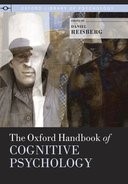
- < Previous chapter
- Next chapter >
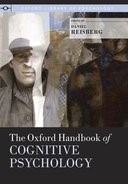
48 Problem Solving
Department of Psychological and Brain Sciences, University of California, Santa Barbara
- Published: 03 June 2013
- Cite Icon Cite
- Permissions Icon Permissions
Problem solving refers to cognitive processing directed at achieving a goal when the problem solver does not initially know a solution method. A problem exists when someone has a goal but does not know how to achieve it. Problems can be classified as routine or nonroutine, and as well defined or ill defined. The major cognitive processes in problem solving are representing, planning, executing, and monitoring. The major kinds of knowledge required for problem solving are facts, concepts, procedures, strategies, and beliefs. Classic theoretical approaches to the study of problem solving are associationism, Gestalt, and information processing. Current issues and suggested future issues include decision making, intelligence and creativity, teaching of thinking skills, expert problem solving, analogical reasoning, mathematical and scientific thinking, everyday thinking, and the cognitive neuroscience of problem solving. Common themes concern the domain specificity of problem solving and a focus on problem solving in authentic contexts.
The study of problem solving begins with defining problem solving, problem, and problem types. This introduction to problem solving is rounded out with an examination of cognitive processes in problem solving, the role of knowledge in problem solving, and historical approaches to the study of problem solving.
Definition of Problem Solving
Problem solving refers to cognitive processing directed at achieving a goal for which the problem solver does not initially know a solution method. This definition consists of four major elements (Mayer, 1992 ; Mayer & Wittrock, 2006 ):
Cognitive —Problem solving occurs within the problem solver’s cognitive system and can only be inferred indirectly from the problem solver’s behavior (including biological changes, introspections, and actions during problem solving). Process —Problem solving involves mental computations in which some operation is applied to a mental representation, sometimes resulting in the creation of a new mental representation. Directed —Problem solving is aimed at achieving a goal. Personal —Problem solving depends on the existing knowledge of the problem solver so that what is a problem for one problem solver may not be a problem for someone who already knows a solution method.
The definition is broad enough to include a wide array of cognitive activities such as deciding which apartment to rent, figuring out how to use a cell phone interface, playing a game of chess, making a medical diagnosis, finding the answer to an arithmetic word problem, or writing a chapter for a handbook. Problem solving is pervasive in human life and is crucial for human survival. Although this chapter focuses on problem solving in humans, problem solving also occurs in nonhuman animals and in intelligent machines.
How is problem solving related to other forms of high-level cognition processing, such as thinking and reasoning? Thinking refers to cognitive processing in individuals but includes both directed thinking (which corresponds to the definition of problem solving) and undirected thinking such as daydreaming (which does not correspond to the definition of problem solving). Thus, problem solving is a type of thinking (i.e., directed thinking).
Reasoning refers to problem solving within specific classes of problems, such as deductive reasoning or inductive reasoning. In deductive reasoning, the reasoner is given premises and must derive a conclusion by applying the rules of logic. For example, given that “A is greater than B” and “B is greater than C,” a reasoner can conclude that “A is greater than C.” In inductive reasoning, the reasoner is given (or has experienced) a collection of examples or instances and must infer a rule. For example, given that X, C, and V are in the “yes” group and x, c, and v are in the “no” group, the reasoning may conclude that B is in “yes” group because it is in uppercase format. Thus, reasoning is a type of problem solving.
Definition of Problem
A problem occurs when someone has a goal but does not know to achieve it. This definition is consistent with how the Gestalt psychologist Karl Duncker ( 1945 , p. 1) defined a problem in his classic monograph, On Problem Solving : “A problem arises when a living creature has a goal but does not know how this goal is to be reached.” However, today researchers recognize that the definition should be extended to include problem solving by intelligent machines. This definition can be clarified using an information processing approach by noting that a problem occurs when a situation is in the given state, the problem solver wants the situation to be in the goal state, and there is no obvious way to move from the given state to the goal state (Newell & Simon, 1972 ). Accordingly, the three main elements in describing a problem are the given state (i.e., the current state of the situation), the goal state (i.e., the desired state of the situation), and the set of allowable operators (i.e., the actions the problem solver is allowed to take). The definition of “problem” is broad enough to include the situation confronting a physician who wishes to make a diagnosis on the basis of preliminary tests and a patient examination, as well as a beginning physics student trying to solve a complex physics problem.
Types of Problems
It is customary in the problem-solving literature to make a distinction between routine and nonroutine problems. Routine problems are problems that are so familiar to the problem solver that the problem solver knows a solution method. For example, for most adults, “What is 365 divided by 12?” is a routine problem because they already know the procedure for long division. Nonroutine problems are so unfamiliar to the problem solver that the problem solver does not know a solution method. For example, figuring out the best way to set up a funding campaign for a nonprofit charity is a nonroutine problem for most volunteers. Technically, routine problems do not meet the definition of problem because the problem solver has a goal but knows how to achieve it. Much research on problem solving has focused on routine problems, although most interesting problems in life are nonroutine.
Another customary distinction is between well-defined and ill-defined problems. Well-defined problems have a clearly specified given state, goal state, and legal operators. Examples include arithmetic computation problems or games such as checkers or tic-tac-toe. Ill-defined problems have a poorly specified given state, goal state, or legal operators, or a combination of poorly defined features. Examples include solving the problem of global warming or finding a life partner. Although, ill-defined problems are more challenging, much research in problem solving has focused on well-defined problems.
Cognitive Processes in Problem Solving
The process of problem solving can be broken down into two main phases: problem representation , in which the problem solver builds a mental representation of the problem situation, and problem solution , in which the problem solver works to produce a solution. The major subprocess in problem representation is representing , which involves building a situation model —that is, a mental representation of the situation described in the problem. The major subprocesses in problem solution are planning , which involves devising a plan for how to solve the problem; executing , which involves carrying out the plan; and monitoring , which involves evaluating and adjusting one’s problem solving.
For example, given an arithmetic word problem such as “Alice has three marbles. Sarah has two more marbles than Alice. How many marbles does Sarah have?” the process of representing involves building a situation model in which Alice has a set of marbles, there is set of marbles for the difference between the two girls, and Sarah has a set of marbles that consists of Alice’s marbles and the difference set. In the planning process, the problem solver sets a goal of adding 3 and 2. In the executing process, the problem solver carries out the computation, yielding an answer of 5. In the monitoring process, the problem solver looks over what was done and concludes that 5 is a reasonable answer. In most complex problem-solving episodes, the four cognitive processes may not occur in linear order, but rather may interact with one another. Although some research focuses mainly on the execution process, problem solvers may tend to have more difficulty with the processes of representing, planning, and monitoring.
Knowledge for Problem Solving
An important theme in problem-solving research is that problem-solving proficiency on any task depends on the learner’s knowledge (Anderson et al., 2001 ; Mayer, 1992 ). Five kinds of knowledge are as follows:
Facts —factual knowledge about the characteristics of elements in the world, such as “Sacramento is the capital of California” Concepts —conceptual knowledge, including categories, schemas, or models, such as knowing the difference between plants and animals or knowing how a battery works Procedures —procedural knowledge of step-by-step processes, such as how to carry out long-division computations Strategies —strategic knowledge of general methods such as breaking a problem into parts or thinking of a related problem Beliefs —attitudinal knowledge about how one’s cognitive processing works such as thinking, “I’m good at this”
Although some research focuses mainly on the role of facts and procedures in problem solving, complex problem solving also depends on the problem solver’s concepts, strategies, and beliefs (Mayer, 1992 ).
Historical Approaches to Problem Solving
Psychological research on problem solving began in the early 1900s, as an outgrowth of mental philosophy (Humphrey, 1963 ; Mandler & Mandler, 1964 ). Throughout the 20th century four theoretical approaches developed: early conceptions, associationism, Gestalt psychology, and information processing.
Early Conceptions
The start of psychology as a science can be set at 1879—the year Wilhelm Wundt opened the first world’s psychology laboratory in Leipzig, Germany, and sought to train the world’s first cohort of experimental psychologists. Instead of relying solely on philosophical speculations about how the human mind works, Wundt sought to apply the methods of experimental science to issues addressed in mental philosophy. His theoretical approach became structuralism —the analysis of consciousness into its basic elements.
Wundt’s main contribution to the study of problem solving, however, was to call for its banishment. According to Wundt, complex cognitive processing was too complicated to be studied by experimental methods, so “nothing can be discovered in such experiments” (Wundt, 1911/1973 ). Despite his admonishments, however, a group of his former students began studying thinking mainly in Wurzburg, Germany. Using the method of introspection, subjects were asked to describe their thought process as they solved word association problems, such as finding the superordinate of “newspaper” (e.g., an answer is “publication”). Although the Wurzburg group—as they came to be called—did not produce a new theoretical approach, they found empirical evidence that challenged some of the key assumptions of mental philosophy. For example, Aristotle had proclaimed that all thinking involves mental imagery, but the Wurzburg group was able to find empirical evidence for imageless thought .
Associationism
The first major theoretical approach to take hold in the scientific study of problem solving was associationism —the idea that the cognitive representations in the mind consist of ideas and links between them and that cognitive processing in the mind involves following a chain of associations from one idea to the next (Mandler & Mandler, 1964 ; Mayer, 1992 ). For example, in a classic study, E. L. Thorndike ( 1911 ) placed a hungry cat in what he called a puzzle box—a wooden crate in which pulling a loop of string that hung from overhead would open a trap door to allow the cat to escape to a bowl of food outside the crate. Thorndike placed the cat in the puzzle box once a day for several weeks. On the first day, the cat engaged in many extraneous behaviors such as pouncing against the wall, pushing its paws through the slats, and meowing, but on successive days the number of extraneous behaviors tended to decrease. Overall, the time required to get out of the puzzle box decreased over the course of the experiment, indicating the cat was learning how to escape.
Thorndike’s explanation for how the cat learned to solve the puzzle box problem is based on an associationist view: The cat begins with a habit family hierarchy —a set of potential responses (e.g., pouncing, thrusting, meowing, etc.) all associated with the same stimulus (i.e., being hungry and confined) and ordered in terms of strength of association. When placed in the puzzle box, the cat executes its strongest response (e.g., perhaps pouncing against the wall), but when it fails, the strength of the association is weakened, and so on for each unsuccessful action. Eventually, the cat gets down to what was initially a weak response—waving its paw in the air—but when that response leads to accidentally pulling the string and getting out, it is strengthened. Over the course of many trials, the ineffective responses become weak and the successful response becomes strong. Thorndike refers to this process as the law of effect : Responses that lead to dissatisfaction become less associated with the situation and responses that lead to satisfaction become more associated with the situation. According to Thorndike’s associationist view, solving a problem is simply a matter of trial and error and accidental success. A major challenge to assocationist theory concerns the nature of transfer—that is, where does a problem solver find a creative solution that has never been performed before? Associationist conceptions of cognition can be seen in current research, including neural networks, connectionist models, and parallel distributed processing models (Rogers & McClelland, 2004 ).
Gestalt Psychology
The Gestalt approach to problem solving developed in the 1930s and 1940s as a counterbalance to the associationist approach. According to the Gestalt approach, cognitive representations consist of coherent structures (rather than individual associations) and the cognitive process of problem solving involves building a coherent structure (rather than strengthening and weakening of associations). For example, in a classic study, Kohler ( 1925 ) placed a hungry ape in a play yard that contained several empty shipping crates and a banana attached overhead but out of reach. Based on observing the ape in this situation, Kohler noted that the ape did not randomly try responses until one worked—as suggested by Thorndike’s associationist view. Instead, the ape stood under the banana, looked up at it, looked at the crates, and then in a flash of insight stacked the crates under the bananas as a ladder, and walked up the steps in order to reach the banana.
According to Kohler, the ape experienced a sudden visual reorganization in which the elements in the situation fit together in a way to solve the problem; that is, the crates could become a ladder that reduces the distance to the banana. Kohler referred to the underlying mechanism as insight —literally seeing into the structure of the situation. A major challenge of Gestalt theory is its lack of precision; for example, naming a process (i.e., insight) is not the same as explaining how it works. Gestalt conceptions can be seen in modern research on mental models and schemas (Gentner & Stevens, 1983 ).
Information Processing
The information processing approach to problem solving developed in the 1960s and 1970s and was based on the influence of the computer metaphor—the idea that humans are processors of information (Mayer, 2009 ). According to the information processing approach, problem solving involves a series of mental computations—each of which consists of applying a process to a mental representation (such as comparing two elements to determine whether they differ).
In their classic book, Human Problem Solving , Newell and Simon ( 1972 ) proposed that problem solving involved a problem space and search heuristics . A problem space is a mental representation of the initial state of the problem, the goal state of the problem, and all possible intervening states (based on applying allowable operators). Search heuristics are strategies for moving through the problem space from the given to the goal state. Newell and Simon focused on means-ends analysis , in which the problem solver continually sets goals and finds moves to accomplish goals.
Newell and Simon used computer simulation as a research method to test their conception of human problem solving. First, they asked human problem solvers to think aloud as they solved various problems such as logic problems, chess, and cryptarithmetic problems. Then, based on an information processing analysis, Newell and Simon created computer programs that solved these problems. In comparing the solution behavior of humans and computers, they found high similarity, suggesting that the computer programs were solving problems using the same thought processes as humans.
An important advantage of the information processing approach is that problem solving can be described with great clarity—as a computer program. An important limitation of the information processing approach is that it is most useful for describing problem solving for well-defined problems rather than ill-defined problems. The information processing conception of cognition lives on as a keystone of today’s cognitive science (Mayer, 2009 ).
Classic Issues in Problem Solving
Three classic issues in research on problem solving concern the nature of transfer (suggested by the associationist approach), the nature of insight (suggested by the Gestalt approach), and the role of problem-solving heuristics (suggested by the information processing approach).
Transfer refers to the effects of prior learning on new learning (or new problem solving). Positive transfer occurs when learning A helps someone learn B. Negative transfer occurs when learning A hinders someone from learning B. Neutral transfer occurs when learning A has no effect on learning B. Positive transfer is a central goal of education, but research shows that people often do not transfer what they learned to solving problems in new contexts (Mayer, 1992 ; Singley & Anderson, 1989 ).
Three conceptions of the mechanisms underlying transfer are specific transfer , general transfer , and specific transfer of general principles . Specific transfer refers to the idea that learning A will help someone learn B only if A and B have specific elements in common. For example, learning Spanish may help someone learn Latin because some of the vocabulary words are similar and the verb conjugation rules are similar. General transfer refers to the idea that learning A can help someone learn B even they have nothing specifically in common but A helps improve the learner’s mind in general. For example, learning Latin may help people learn “proper habits of mind” so they are better able to learn completely unrelated subjects as well. Specific transfer of general principles is the idea that learning A will help someone learn B if the same general principle or solution method is required for both even if the specific elements are different.
In a classic study, Thorndike and Woodworth ( 1901 ) found that students who learned Latin did not subsequently learn bookkeeping any better than students who had not learned Latin. They interpreted this finding as evidence for specific transfer—learning A did not transfer to learning B because A and B did not have specific elements in common. Modern research on problem-solving transfer continues to show that people often do not demonstrate general transfer (Mayer, 1992 ). However, it is possible to teach people a general strategy for solving a problem, so that when they see a new problem in a different context they are able to apply the strategy to the new problem (Judd, 1908 ; Mayer, 2008 )—so there is also research support for the idea of specific transfer of general principles.
Insight refers to a change in a problem solver’s mind from not knowing how to solve a problem to knowing how to solve it (Mayer, 1995 ; Metcalfe & Wiebe, 1987 ). In short, where does the idea for a creative solution come from? A central goal of problem-solving research is to determine the mechanisms underlying insight.
The search for insight has led to five major (but not mutually exclusive) explanatory mechanisms—insight as completing a schema, insight as suddenly reorganizing visual information, insight as reformulation of a problem, insight as removing mental blocks, and insight as finding a problem analog (Mayer, 1995 ). Completing a schema is exemplified in a study by Selz (Fridja & de Groot, 1982 ), in which people were asked to think aloud as they solved word association problems such as “What is the superordinate for newspaper?” To solve the problem, people sometimes thought of a coordinate, such as “magazine,” and then searched for a superordinate category that subsumed both terms, such as “publication.” According to Selz, finding a solution involved building a schema that consisted of a superordinate and two subordinate categories.
Reorganizing visual information is reflected in Kohler’s ( 1925 ) study described in a previous section in which a hungry ape figured out how to stack boxes as a ladder to reach a banana hanging above. According to Kohler, the ape looked around the yard and found the solution in a flash of insight by mentally seeing how the parts could be rearranged to accomplish the goal.
Reformulating a problem is reflected in a classic study by Duncker ( 1945 ) in which people are asked to think aloud as they solve the tumor problem—how can you destroy a tumor in a patient without destroying surrounding healthy tissue by using rays that at sufficient intensity will destroy any tissue in their path? In analyzing the thinking-aloud protocols—that is, transcripts of what the problem solvers said—Duncker concluded that people reformulated the goal in various ways (e.g., avoid contact with healthy tissue, immunize healthy tissue, have ray be weak in healthy tissue) until they hit upon a productive formulation that led to the solution (i.e., concentrating many weak rays on the tumor).
Removing mental blocks is reflected in classic studies by Duncker ( 1945 ) in which solving a problem involved thinking of a novel use for an object, and by Luchins ( 1942 ) in which solving a problem involved not using a procedure that had worked well on previous problems. Finding a problem analog is reflected in classic research by Wertheimer ( 1959 ) in which learning to find the area of a parallelogram is supported by the insight that one could cut off the triangle on one side and place it on the other side to form a rectangle—so a parallelogram is really a rectangle in disguise. The search for insight along each of these five lines continues in current problem-solving research.
Heuristics are problem-solving strategies, that is, general approaches to how to solve problems. Newell and Simon ( 1972 ) suggested three general problem-solving heuristics for moving from a given state to a goal state: random trial and error , hill climbing , and means-ends analysis . Random trial and error involves randomly selecting a legal move and applying it to create a new problem state, and repeating that process until the goal state is reached. Random trial and error may work for simple problems but is not efficient for complex ones. Hill climbing involves selecting the legal move that moves the problem solver closer to the goal state. Hill climbing will not work for problems in which the problem solver must take a move that temporarily moves away from the goal as is required in many problems.
Means-ends analysis involves creating goals and seeking moves that can accomplish the goal. If a goal cannot be directly accomplished, a subgoal is created to remove one or more obstacles. Newell and Simon ( 1972 ) successfully used means-ends analysis as the search heuristic in a computer program aimed at general problem solving, that is, solving a diverse collection of problems. However, people may also use specific heuristics that are designed to work for specific problem-solving situations (Gigerenzer, Todd, & ABC Research Group, 1999 ; Kahneman & Tversky, 1984 ).
Current and Future Issues in Problem Solving
Eight current issues in problem solving involve decision making, intelligence and creativity, teaching of thinking skills, expert problem solving, analogical reasoning, mathematical and scientific problem solving, everyday thinking, and the cognitive neuroscience of problem solving.
Decision Making
Decision making refers to the cognitive processing involved in choosing between two or more alternatives (Baron, 2000 ; Markman & Medin, 2002 ). For example, a decision-making task may involve choosing between getting $240 for sure or having a 25% change of getting $1000. According to economic theories such as expected value theory, people should chose the second option, which is worth $250 (i.e., .25 x $1000) rather than the first option, which is worth $240 (1.00 x $240), but psychological research shows that most people prefer the first option (Kahneman & Tversky, 1984 ).
Research on decision making has generated three classes of theories (Markman & Medin, 2002 ): descriptive theories, such as prospect theory (Kahneman & Tversky), which are based on the ideas that people prefer to overweight the cost of a loss and tend to overestimate small probabilities; heuristic theories, which are based on the idea that people use a collection of short-cut strategies such as the availability heuristic (Gigerenzer et al., 1999 ; Kahneman & Tversky, 2000 ); and constructive theories, such as mental accounting (Kahneman & Tversky, 2000 ), in which people build a narrative to justify their choices to themselves. Future research is needed to examine decision making in more realistic settings.
Intelligence and Creativity
Although researchers do not have complete consensus on the definition of intelligence (Sternberg, 1990 ), it is reasonable to view intelligence as the ability to learn or adapt to new situations. Fluid intelligence refers to the potential to solve problems without any relevant knowledge, whereas crystallized intelligence refers to the potential to solve problems based on relevant prior knowledge (Sternberg & Gregorenko, 2003 ). As people gain more experience in a field, their problem-solving performance depends more on crystallized intelligence (i.e., domain knowledge) than on fluid intelligence (i.e., general ability) (Sternberg & Gregorenko, 2003 ). The ability to monitor and manage one’s cognitive processing during problem solving—which can be called metacognition —is an important aspect of intelligence (Sternberg, 1990 ). Research is needed to pinpoint the knowledge that is needed to support intelligent performance on problem-solving tasks.
Creativity refers to the ability to generate ideas that are original (i.e., other people do not think of the same idea) and functional (i.e., the idea works; Sternberg, 1999 ). Creativity is often measured using tests of divergent thinking —that is, generating as many solutions as possible for a problem (Guilford, 1967 ). For example, the uses test asks people to list as many uses as they can think of for a brick. Creativity is different from intelligence, and it is at the heart of creative problem solving—generating a novel solution to a problem that the problem solver has never seen before. An important research question concerns whether creative problem solving depends on specific knowledge or creativity ability in general.
Teaching of Thinking Skills
How can people learn to be better problem solvers? Mayer ( 2008 ) proposes four questions concerning teaching of thinking skills:
What to teach —Successful programs attempt to teach small component skills (such as how to generate and evaluate hypotheses) rather than improve the mind as a single monolithic skill (Covington, Crutchfield, Davies, & Olton, 1974 ). How to teach —Successful programs focus on modeling the process of problem solving rather than solely reinforcing the product of problem solving (Bloom & Broder, 1950 ). Where to teach —Successful programs teach problem-solving skills within the specific context they will be used rather than within a general course on how to solve problems (Nickerson, 1999 ). When to teach —Successful programs teaching higher order skills early rather than waiting until lower order skills are completely mastered (Tharp & Gallimore, 1988 ).
Overall, research on teaching of thinking skills points to the domain specificity of problem solving; that is, successful problem solving depends on the problem solver having domain knowledge that is relevant to the problem-solving task.
Expert Problem Solving
Research on expertise is concerned with differences between how experts and novices solve problems (Ericsson, Feltovich, & Hoffman, 2006 ). Expertise can be defined in terms of time (e.g., 10 years of concentrated experience in a field), performance (e.g., earning a perfect score on an assessment), or recognition (e.g., receiving a Nobel Prize or becoming Grand Master in chess). For example, in classic research conducted in the 1940s, de Groot ( 1965 ) found that chess experts did not have better general memory than chess novices, but they did have better domain-specific memory for the arrangement of chess pieces on the board. Chase and Simon ( 1973 ) replicated this result in a better controlled experiment. An explanation is that experts have developed schemas that allow them to chunk collections of pieces into a single configuration.
In another landmark study, Larkin et al. ( 1980 ) compared how experts (e.g., physics professors) and novices (e.g., first-year physics students) solved textbook physics problems about motion. Experts tended to work forward from the given information to the goal, whereas novices tended to work backward from the goal to the givens using a means-ends analysis strategy. Experts tended to store their knowledge in an integrated way, whereas novices tended to store their knowledge in isolated fragments. In another study, Chi, Feltovich, and Glaser ( 1981 ) found that experts tended to focus on the underlying physics concepts (such as conservation of energy), whereas novices tended to focus on the surface features of the problem (such as inclined planes or springs). Overall, research on expertise is useful in pinpointing what experts know that is different from what novices know. An important theme is that experts rely on domain-specific knowledge rather than solely general cognitive ability.
Analogical Reasoning
Analogical reasoning occurs when people solve one problem by using their knowledge about another problem (Holyoak, 2005 ). For example, suppose a problem solver learns how to solve a problem in one context using one solution method and then is given a problem in another context that requires the same solution method. In this case, the problem solver must recognize that the new problem has structural similarity to the old problem (i.e., it may be solved by the same method), even though they do not have surface similarity (i.e., the cover stories are different). Three steps in analogical reasoning are recognizing —seeing that a new problem is similar to a previously solved problem; abstracting —finding the general method used to solve the old problem; and mapping —using that general method to solve the new problem.
Research on analogical reasoning shows that people often do not recognize that a new problem can be solved by the same method as a previously solved problem (Holyoak, 2005 ). However, research also shows that successful analogical transfer to a new problem is more likely when the problem solver has experience with two old problems that have the same underlying structural features (i.e., they are solved by the same principle) but different surface features (i.e., they have different cover stories) (Holyoak, 2005 ). This finding is consistent with the idea of specific transfer of general principles as described in the section on “Transfer.”
Mathematical and Scientific Problem Solving
Research on mathematical problem solving suggests that five kinds of knowledge are needed to solve arithmetic word problems (Mayer, 2008 ):
Factual knowledge —knowledge about the characteristics of problem elements, such as knowing that there are 100 cents in a dollar Schematic knowledge —knowledge of problem types, such as being able to recognize time-rate-distance problems Strategic knowledge —knowledge of general methods, such as how to break a problem into parts Procedural knowledge —knowledge of processes, such as how to carry our arithmetic operations Attitudinal knowledge —beliefs about one’s mathematical problem-solving ability, such as thinking, “I am good at this”
People generally possess adequate procedural knowledge but may have difficulty in solving mathematics problems because they lack factual, schematic, strategic, or attitudinal knowledge (Mayer, 2008 ). Research is needed to pinpoint the role of domain knowledge in mathematical problem solving.
Research on scientific problem solving shows that people harbor misconceptions, such as believing that a force is needed to keep an object in motion (McCloskey, 1983 ). Learning to solve science problems involves conceptual change, in which the problem solver comes to recognize that previous conceptions are wrong (Mayer, 2008 ). Students can be taught to engage in scientific reasoning such as hypothesis testing through direct instruction in how to control for variables (Chen & Klahr, 1999 ). A central theme of research on scientific problem solving concerns the role of domain knowledge.
Everyday Thinking
Everyday thinking refers to problem solving in the context of one’s life outside of school. For example, children who are street vendors tend to use different procedures for solving arithmetic problems when they are working on the streets than when they are in school (Nunes, Schlieman, & Carraher, 1993 ). This line of research highlights the role of situated cognition —the idea that thinking always is shaped by the physical and social context in which it occurs (Robbins & Aydede, 2009 ). Research is needed to determine how people solve problems in authentic contexts.
Cognitive Neuroscience of Problem Solving
The cognitive neuroscience of problem solving is concerned with the brain activity that occurs during problem solving. For example, using fMRI brain imaging methodology, Goel ( 2005 ) found that people used the language areas of the brain to solve logical reasoning problems presented in sentences (e.g., “All dogs are pets…”) and used the spatial areas of the brain to solve logical reasoning problems presented in abstract letters (e.g., “All D are P…”). Cognitive neuroscience holds the potential to make unique contributions to the study of problem solving.
Problem solving has always been a topic at the fringe of cognitive psychology—too complicated to study intensively but too important to completely ignore. Problem solving—especially in realistic environments—is messy in comparison to studying elementary processes in cognition. The field remains fragmented in the sense that topics such as decision making, reasoning, intelligence, expertise, mathematical problem solving, everyday thinking, and the like are considered to be separate topics, each with its own separate literature. Yet some recurring themes are the role of domain-specific knowledge in problem solving and the advantages of studying problem solving in authentic contexts.
Future Directions
Some important issues for future research include the three classic issues examined in this chapter—the nature of problem-solving transfer (i.e., How are people able to use what they know about previous problem solving to help them in new problem solving?), the nature of insight (e.g., What is the mechanism by which a creative solution is constructed?), and heuristics (e.g., What are some teachable strategies for problem solving?). In addition, future research in problem solving should continue to pinpoint the role of domain-specific knowledge in problem solving, the nature of cognitive ability in problem solving, how to help people develop proficiency in solving problems, and how to provide aids for problem solving.
Anderson L. W. , Krathwohl D. R. , Airasian P. W. , Cruikshank K. A. , Mayer R. E. , Pintrich P. R. , Raths, J., & Wittrock M. C. ( 2001 ). A taxonomy for learning, teaching, and assessing: A revision of Bloom’s taxonomy of educational objectives. New York : Longman.
Baron J. ( 2000 ). Thinking and deciding (3rd ed.). New York : Cambridge University Press.
Google Scholar
Google Preview
Bloom B. S. , & Broder B. J. ( 1950 ). Problem-solving processes of college students: An exploratory investigation. Chicago : University of Chicago Press.
Chase W. G. , & Simon H. A. ( 1973 ). Perception in chess. Cognitive Psychology, 4, 55–81.
Chen Z. , & Klahr D. ( 1999 ). All other things being equal: Acquisition and transfer of the control of variable strategy . Child Development, 70, 1098–1120.
Chi M. T. H. , Feltovich P. J. , & Glaser R. ( 1981 ). Categorization and representation of physics problems by experts and novices. Cognitive Science, 5, 121–152.
Covington M. V. , Crutchfield R. S. , Davies L. B. , & Olton R. M. ( 1974 ). The productive thinking program. Columbus, OH : Merrill.
de Groot A. D. ( 1965 ). Thought and choice in chess. The Hague, The Netherlands : Mouton.
Duncker K. ( 1945 ). On problem solving. Psychological Monographs, 58 (3) (Whole No. 270).
Ericsson K. A. , Feltovich P. J. , & Hoffman R. R. (Eds.). ( 2006 ). The Cambridge handbook of expertise and expert performance. New York : Cambridge University Press.
Fridja N. H. , & de Groot A. D. ( 1982 ). Otto Selz: His contribution to psychology. The Hague, The Netherlands : Mouton.
Gentner D. , & Stevens A. L. (Eds.). ( 1983 ). Mental models. Hillsdale, NJ : Erlbaum.
Gigerenzer G. , Todd P. M. , & ABC Research Group (Eds.). ( 1999 ). Simple heuristics that make us smart. Oxford, England : Oxford University Press.
Goel V. ( 2005 ). Cognitive neuroscience of deductive reasoning. In K. J. Holyoak & R. G. Morrison (Eds.), The Cambridge handbook of thinking and reasoning (pp. 475–492). New York : Cambridge University Press.
Guilford J. P. ( 1967 ). The nature of human intelligence. New York : McGraw-Hill.
Holyoak K. J. ( 2005 ). Analogy. In K. J. Holyoak & R. G. Morrison (Eds.), The Cambridge handbook of thinking and reasoning (pp. 117–142). New York : Cambridge University Press.
Humphrey G. ( 1963 ). Thinking: An introduction to experimental psychology. New York : Wiley.
Judd C. H. ( 1908 ). The relation of special training and general intelligence. Educational Review, 36, 28–42.
Kahneman D. , & Tversky A. ( 1984 ). Choices, values, and frames. American Psychologist, 39, 341–350.
Kahneman D. , & Tversky A. (Eds.). ( 2000 ). Choices, values, and frames. New York : Cambridge University Press.
Kohler W. ( 1925 ). The mentality of apes. New York : Liveright.
Larkin J. H. , McDermott J. , Simon D. P. , & Simon H. A. ( 1980 ). Expert and novice performance in solving physics problems. Science, 208, 1335–1342.
Luchins A. ( 1942 ). Mechanization in problem solving. Psychological Monographs, 54 (6) (Whole No. 248).
Mandler J. M. , & Mandler G. ( 1964 ). Thinking from associationism to Gestalt. New York : Wiley.
Markman A. B. , & Medin D. L. ( 2002 ). Decision making. In D. Medin (Ed.), Stevens’ handbook of experimental psychology, Vol. 2. Memory and cognitive processes (2nd ed., pp. 413–466). New York : Wiley.
Mayer R. E. ( 1992 ). Thinking, problem solving, cognition (2nd ed). New York : Freeman.
Mayer R. E. ( 1995 ). The search for insight: Grappling with Gestalt psychology’s unanswered questions. In R. J. Sternberg & J. E. Davidson (Eds.), The nature of insight (pp. 3–32). Cambridge, MA : MIT Press.
Mayer R. E. ( 2008 ). Learning and instruction. Upper Saddle River, NJ : Merrill Prentice Hall.
Mayer R. E. ( 2009 ). Information processing. In T. L. Good (Ed.), 21st century education: A reference handbook (pp. 168–174). Thousand Oaks, CA : Sage.
Mayer R. E. , & Wittrock M. C. ( 2006 ). Problem solving. In P. A. Alexander & P. H. Winne (Eds.), Handbook of educational psychology (2nd ed., pp. 287–304). Mahwah, NJ : Erlbaum.
McCloskey M. ( 1983 ). Intuitive physics. Scientific American, 248 (4), 122–130.
Metcalfe J. , & Wiebe D. ( 1987 ). Intuition in insight and non-insight problem solving. Memory and Cognition, 15, 238–246.
Newell A. , & Simon H. A. ( 1972 ). Human problem solving. Englewood Cliffs, NJ : Prentice-Hall.
Nickerson R. S. ( 1999 ). Enhancing creativity. In R. J. Sternberg (Ed.), Handbook of creativity (pp. 392–430). New York : Cambridge University Press.
Nunes T. , Schliemann A. D. , & Carraher D. W , ( 1993 ). Street mathematics and school mathematics. Cambridge, England : Cambridge University Press.
Robbins P. , & Aydede M. (Eds.). ( 2009 ). The Cambridge handbook of situated cognition. New York : Cambridge University Press.
Rogers T. T. , & McClelland J. L. ( 2004 ). Semantic cognition: A parallel distributed processing approach. Cambridge, MA : MIT Press.
Singley M. K. , & Anderson J. R. ( 1989 ). The transfer of cognitive skill. Cambridge, MA : Harvard University Press.
Sternberg R. J. ( 1990 ). Metaphors of mind: Conceptions of the nature of intelligence. New York : Cambridge University Press.
Sternberg R. J. ( 1999 ). Handbook of creativity. New York : Cambridge University Press.
Sternberg R. J. , & Gregorenko E. L. (Eds.). ( 2003 ). The psychology of abilities, competencies, and expertise. New York : Cambridge University Press.
Tharp R. G. , & Gallimore R. ( 1988 ). Rousing minds to life: Teaching, learning, and schooling in social context. New York : Cambridge University Press.
Thorndike E. L. ( 1911 ). Animal intelligence. New York: Hafner.
Thorndike E. L. , & Woodworth R. S. ( 1901 ). The influence of improvement in one mental function upon the efficiency of other functions. Psychological Review, 8, 247–261.
Wertheimer M. ( 1959 ). Productive thinking. New York : Harper and Collins.
Wundt W. ( 1973 ). An introduction to experimental psychology. New York : Arno Press. (Original work published in 1911).
Further Reading
Baron, J. ( 2008 ). Thinking and deciding (4th ed). New York: Cambridge University Press.
Duncker, K. ( 1945 ). On problem solving. Psychological Monographs , 58(3) (Whole No. 270).
Holyoak, K. J. , & Morrison, R. G. ( 2005 ). The Cambridge handbook of thinking and reasoning . New York: Cambridge University Press.
Mayer, R. E. , & Wittrock, M. C. ( 2006 ). Problem solving. In P. A. Alexander & P. H. Winne (Eds.), Handbook of educational psychology (2nd ed., pp. 287–304). Mahwah, NJ: Erlbaum.
Sternberg, R. J. , & Ben-Zeev, T. ( 2001 ). Complex cognition: The psychology of human thought . New York: Oxford University Press.
Weisberg, R. W. ( 2006 ). Creativity . New York: Wiley.
- About Oxford Academic
- Publish journals with us
- University press partners
- What we publish
- New features
- Open access
- Institutional account management
Rights and permissions
- Get help with access
- Accessibility
- Advertising
- Media enquiries
- Oxford University Press
- Oxford Languages
- University of Oxford
Oxford University Press is a department of the University of Oxford. It furthers the University's objective of excellence in research, scholarship, and education by publishing worldwide
- Copyright © 2024 Oxford University Press
- Cookie settings
- Cookie policy
- Privacy policy
- Legal notice
This Feature Is Available To Subscribers Only
Sign In or Create an Account
This PDF is available to Subscribers Only
For full access to this pdf, sign in to an existing account, or purchase an annual subscription.
Problem-Solving Theory: The Task-Centred Model
- Living reference work entry
- First Online: 12 April 2022
- Cite this living reference work entry
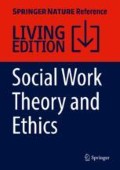
- Blanca M. Ramos 5 &
- Randall L. Stetson 6
Part of the book series: Social Work ((SOWO))
399 Accesses
This chapter examines the task-centred model to illustrate the application of problem-solving theory for social work intervention. First, it provides a brief description of the problem-solving model. Its historical development and key principles and concepts are presented. Next, the chapter offers a general overview of the crisis intervention model. The task-centred model and crisis intervention share principles and methods drawn from problem-solving theory. The remainder of the chapter focuses on the task-centred model. It reviews its historical background, viability as a framework for social work generalist practice, as well as its applicability with diverse client populations and across cultural settings. The structured steps that guide task-centred implementation throughout the helping process are described. A brief critical review of the model’s strengths and limitations is provided. The chapter concludes with a brief summary and some closing thoughts.
- Problem-solving theory
- Task-centered model
- Task-centered practice
- Generalist social work practice
- Crisis intervention
- Multiculturalism
This is a preview of subscription content, log in via an institution to check access.
Access this chapter
Institutional subscriptions
Brieland D (1977) Historical overview. Soc Work 22(5):341–346. http://www.jstor.org.libezproxy2.syr.edu/stable/23712810
Google Scholar
Coady N, Lehmann P (2016) The problem-solving model: a framework for integrating the science and art of practice. In: Lehmann P, Coady N (eds) Theoretical perspectives for direct social work practice: a generalist-eclectic approach, 3rd edn. Springer
Chapter Google Scholar
D’Zurilla TJ, Goldfried MR (1971) Problem solving and behavior modification. J Abnorm Psychol 78(1):107–126. https://doi.org/10.1037/h0031360
Article Google Scholar
Dattilio F (1998) Cognitive behavioral therapy. In: Dattilio M (ed) Case studies in couple and family therapy: systems and cognitive perspectives. Guilford, New York, pp 62–82
Dohert W (1981) Cognitive processes in intimate conflicts: extending attribution theory. Am J Fam Ther 9:3–12
Duckword G (1967) A project in crisis intervention. Soc Casework 48(4):227–231
Fortune AE (2012) Development of the task-centered model. In: Rzepnicki TL, McCracken SG, Briggs HE (eds) From task-centered social work to evidence-based and integrative practice: reflections on history and implementation. Oxford University Press, pp 15–39
Fortune AE, Reid WJ (2011) Task-centered social work. In: Turner F (ed) Social work treatment: interlocking theoretical approaches, 6th edn. Oxford University Press, New York, pp 513–532
Fortune AE, McCallion P, Briar-Lawson K (Eds.) (2010) Social work practice research for the 21st century. New York: Columbia University Press
Fortune AE, Ramos BM, Reid WJ (2022) Task-Centered practice. In: Lisa Rapp-McCall, Kevin Corcoran & Albert R. Roberts, (eds.), Social workers’ desk reference, 4th edn Oxford University Press, New York
Fortune AE, Ramos BM, Reid WJ (2022) Task-Centered Practice. In: Lisa Rapp-McCall, Kevin Corcoran, Albert R Roberts, (Eds.). Social Workers’ Desk Reference, 4th edition. New York: Oxford University Press
Garfield SL (1994) Research on client variables in psychotherapy. In: Bergin A, Garfield S (eds) Handbook of psychotherapy and behavior change, 4th edn. Wiley, New York, pp 190–228
Golan N, Carey H, Hyttinnen E (1969) The emerging role of the social worker in the psychiatric emergency service. Community Ment Health J 5(1):55–61
Gorey KM, Thyer BA, Pawfuck DE (1998) Differential effectiveness of prevalent social work practice models: a meta-analysis. Soc Work 43:269–278
Hollis F (1970) The psychosocial approach to the practice of casework. In: Theories of social casework. University of Chicago Press, pp 33–75
Hoyt MF (2000) Some stories are better than others: doing what works in brief therapy and managed care. Brunner/Mazel, Philadelphia
Hubble M, Duncan B, Miller S (1999) Introduction. In: Hubble M, Duncan B, Miller S (eds) The heart and soul of change: what works in therapy. American Psychological Association, Washington, DC
Huh NS, Koh YS (2010) Task-centered practice in South Korea. In: Fortune AE, McCallion P, Briar-Lawson K (eds) Social work practice research for the 21st century. Columbia University Press, New York, pp 235–239
Jagt N, Jagt L (2010) Task-centered practice in the Netherlands. In: Fortune AE, McCallion P, Briar-Lawson K (eds) Social work practice research for the 21st century. Columbia University Press, New York, pp 208–212
Lo TW (2010) Task-centered practice in Hong Kong. In: Fortune AE, McCallion P, Briar-Lawson K (eds) Social work practice research for the 21st century. Columbia University Press, New York, pp 240–244
Malouff JM, Thorsteinsson EB, Schutte NS (2007) The efficacy of problem-solving therapy in reducing mental and physical health problems: a meta-analysis. Clin Psychol Rev 27(1):46–57
Marsh P (2010) Task-centered practice in Great Britain. In: Fortune AE, McCallion P, Briar-Lawson K (eds) Social work practice research for the 21st century. Columbia University Press, New York, pp 203–2007
Marsh P, Doel M (2005) The task-centred book. Routledge, Abingdon/New York
Book Google Scholar
Miley K, O’Melia M, DuBois (2017) Generalist social work practice: an empowering approach. Allyn & Bacon, Boston
Morris B (1968) Crisis intervention in a public welfare agency. Soc Casework 49(10):612–617
Naleppa M (2010) Task-centered practice in Germany. In: Fortune AE, McCallion P, Briar-Lawson K (eds) Social work practice research for the 21st century. Columbia University Press, New York, pp 213–216
Nezu AM, Nezu CM, D’Zurilla T (2012) Problem-solving therapy: a treatment manual. Springer
Nichols M, Schwartz R (2001) Family therapy. Allyn and Bacon, Needham Heights
Parad HJ (1958) Ego psychology and dynamic casework. Family Association of America, New York
Parad H (1965) Preventive casework: problems and implications. In: Parad H (ed) Crisis intervention: selected readings. Family Service Association of America, New York
Parad H (1966) The use of time-limited crisis interventions in community mental health programming. Soc Serv Rev 40(3):275–282
Parad H, Capland G (1960) A framework for studying families in crisis. Soc Work 5(3):3–15
Parad H, Parad G (1968) A study of crisis oriented planned short-term treatment. Soc Casework 49(6):346–355
Payne M (2014) Modern social work theory, 3rd edn. Palgrave Macmillan, Basingstoke
Perlman HH (1957) Social casework: a problem-solving process. University of Chicago Press, Chicago
Poal P (1990) Introduction to the theory and practice of crisis intervention. Quadernos Psicol 10:121–140
Ramos BM, Garvin C (2003) Task centered treatment with culturally diverse populations. In: Tolson E, Reid W, Garvin C (eds) Generalist practice: a task centered approach, pp. Columbia University Press, New York, pp 441–463
Ramos B, Tolson E (2016) The task-centered model. In: Lehmann P, Coady N (eds) Theoretical perspectives for direct social work practice: a generalist-eclectic approach, 3rd edn. Springer
Regehr C (2017) Crisis theory and social work treatment. In: Turner F (ed) Social work treatment: interlocking theoretical approaches. Oxford University Press
Reid WJ (1992) Task strategies: an empirical approach to social work practice. Columbia University Press, New York
Reid WJ, Epstein L (eds) (1972) Task-centered casework. Columbia University Press, New York
Reid W, Ramos B (2002) Intervención “Centrada en la Tarea”, un Modelo de Práctica de Trabajo Social. Rev Treball Soc 168:6–22
Reid WJ, Shyne AW (1969) Brief and extended casework. Columbia University Press, New York
Roberts A (2005) Bridging the past and present to the future of crisis intervention and case management. In: Roberts A (ed) Crisis intervention handbook: assessment, treatment, and research, 3rd edn. Oxford University Press
Rooney RH (2010) Task-centered practice in the United States. In: Fortune AE, McCallion P, Briar-Lawson K (eds) Social work practice research for the 21st century. Columbia University Press, New York, pp 195–202
Ruben D (1998) Social exchange theory: dynamics of a system governing the dysfunctional family and guide to assessment. J Contemp Psychother 8(3):307–325
Schatz MS, Jenkins LE, Sheafor BW (1990) Milford redefined: a model of initial and advanced generalist social work [Article]. J Soc Work Educ 26(3):217–231. https://doi.org/10.1080/10437797.1990.10672154
Strean HS (1968) Some reactions of case workers to the war on poverty. J Contemp Psychother 1:43–48
Strickler M (1965) Applying crisis theory in a community clinic. Soc Casework 46:150–154
Studt E (1968) Social work theory and implication for the practice of methods. Soc Work Educ Report 16:22–46
Tolson R, Reid W, Garvin C (2003) Generalist practice: a task-centered approach, 2nd edn. Columbia University Press, New York
Trotter C (2010) Task-centred practice in Australia. In Fortune AE, McCallion P, Briar-Lawson K (Eds.), Social work practice research for the 21st century, 235–239. New York: Columbia University Press
Watzlawick P, Bervin J, Jackson D (1967) Pragmatics of human communication. W.W. Norton, New York
Download references
Author information
Authors and affiliations.
State University of New York at Albany, Albany, NY, USA
Blanca M. Ramos
State University of New York at Oswego, Oswego, NY, USA
Randall L. Stetson
You can also search for this author in PubMed Google Scholar
Corresponding author
Correspondence to Blanca M. Ramos .
Editor information
Editors and affiliations.
School of Human Services and Social Work, Griffith University, Meadowbrook, QLD, Australia
Dorothee Hölscher
School of Social Sciences, UNSW Sydney, Sydney, NSW, Australia
Richard Hugman
Donna McAuliffe
Reprints and permissions
Copyright information
© 2022 Springer Nature Singapore Pte Ltd.
About this entry
Cite this entry.
Ramos, B.M., Stetson, R.L. (2022). Problem-Solving Theory: The Task-Centred Model. In: Hölscher, D., Hugman, R., McAuliffe, D. (eds) Social Work Theory and Ethics. Social Work. Springer, Singapore. https://doi.org/10.1007/978-981-16-3059-0_9-1
Download citation
DOI : https://doi.org/10.1007/978-981-16-3059-0_9-1
Received : 24 December 2021
Accepted : 25 January 2022
Published : 12 April 2022
Publisher Name : Springer, Singapore
Print ISBN : 978-981-16-3059-0
Online ISBN : 978-981-16-3059-0
eBook Packages : Social Sciences Reference Module Humanities and Social Sciences Reference Module Business, Economics and Social Sciences
- Publish with us
Policies and ethics
- Find a journal
- Track your research

solving that change the problematic situation and can have an influe nce on the solving process. The resolution of the problem can be described as a state characterized as the removal ...
Problem - solving knowledge is, conceptually, of two kinds. Declarative knowledge is knowing that something is the case. It is knowledge of facts, theories, events, and objects. Proce-dural knowledge is knowing how to do something. It includes motor skills, cognitive skills, and cognitive strategies. Both declarative and procedural knowledge are ...
problem solving proposed in the preceding chapters. Janet E. Davidson is Associate Professor of Psychology at Lewis & Clark College. She conducts research on several aspects of problem solving , including the roles that insight and metacognitive skills play in problem solving . Robert J. Sternberg is IBM Professor of Psychology and Education at
Problem Solving Connects Theory and Practice A perennial charge brought against education is that it fails to prepare students for the real world. It teaches theory but not practice. Problem solving connects theory and practice. In a sense this element is the same as the definitions of problem solving and
The problem solving is a personal and aimed process. That means that the activities done by an individual during the problem solving process are led to his/her personal aim (Mayer and Wittrock, 2006). An individual has to identify the problem first and then seek for possible solutions (Mayer and Wittrock, 2006).
we must simplify our problem formulations drastically, even leaving out much or most of what is potentially relevant. The descriptive theory of problem solving and decision making is centrally concerned with how people cut problems down to size: how they apply approximate, heuristic techniques to handle complexity that cannot be handled exactly.
Problem recognition, definition, and representation are metalevel exec-utive processes, called metacomponents in Sternberg’s (1985) triarchic theory of human intelligence. This theory proposes that metacompo-nents guide problem solving by planning, monitoring, and evaluating the problem - solving process.
Problem solving refers to cognitive processing directed at achieving a goal when the problem solver does not initially know a solution method. A problem exists when someone has a goal but does not know how to achieve it. Problems can be classified as routine or nonroutine, and as well defined or ill defined.
Definition 3: Problem solving is a four-stage. process involving Perceiving (awareness of) the situation as problematic; Searching for and processing information relevant to selecting an effective problem - solving activity; Engaging in a problem - solving activity; and Evaluating the outcome of the activity.
Blanca M. Ramos and Randall L. Stetson. Abstract. This chapter examines the task-centred model to illustrate the application of problem - solving theory for social work intervention. First, it provides a brief description of the problem - solving model. Its historical development and key principles and concepts are presented.

IMAGES
VIDEO
COMMENTS
Versatile five-cabin layout. The 55m/180'5" motor yacht 'Step One' was built by Amels in the Netherlands at their Vissingen shipyard. Her interior is styled by Italian designer design house Laura Sessa Romboli and she was delivered to her owner in May 2012. This luxury vessel's exterior design is the work of Tim Heywood Design and she was last ...
The STEP ONE yacht is a 180.4ft / 55m luxury yacht built and launched by yacht builder Amels. Delivered to a proud yacht owner in 2012 and refit in 2020, this luxury yacht sleeps up to 12 guests in 5 staterooms and has accommodations for 16 crew. She has a beam of 29.5ft / 9m, a draft of 11.2ft / 3.4m, and she measures in at 672 gross tons.
The 55 metre motor yacht Step One is back on the market, jointly listed for sale with Y.CO and Inigo Nicholson Yacht. She joins the sales fleet fresh from a multi-million dollar refit that has left her in exacting condition and ready to welcome a new owner. With naval architecture by Tim Heywood, Step One was built by Dutch yard Amels in steel ...
672GT. A Step above the rest. One of Amels' highly successful 180 Limited Editions, 55 metre Step One was built on a proven hull and engineering platform with Northern European pedigree. Her extended split-level sundeck is one of the largest on the water for a yacht of this size, offering shaded dining, bar, BBQ, sunbathing spaces and a Jacuzzi.
Completed Amels Yacht STEP ONE. Built by the innovative AMELS yard and delivered in 2012, STEP ONE is the first AMELS 180 from the successful Limited Editions range. Dutch luxury builder AMELS bridges the gap between semi-custom and fully custom yachts with the Limited Editions concept. Tim Heywood, the famed British designer, is responsible ...
Motor YACHT STEP ONE. The STEP ONE yacht is a 180' 6" (55m) luxury yacht, launched and delivered to her original owner by the leading yacht builder AMELS yachts in 2012, and refit in 2015 . The brilliantly appointed interior accommodations has a 5 stateroom layout, which accommodates 12 guests, and crew accommodations for up to 14 crew.
Step One is a motor yacht with an overall length of m. The yacht's builder is Amels from The Netherlands, who launched Step One in 2012. The superyacht has a beam of m, a draught of m and a volume of . GT.. Step One features exterior design by Tim Heywood Design Ltd. and interior design by Studio Laura Sessa. Up to 10 guests can be accommodated on board the superyacht, Step One, and she also ...
STEP ONE is a 55.0 m Motor Yacht, built in Netherlands by Amels and delivered in 2012. She is one of 14 LE 180 models. Her top speed is 15.5 kn and she boasts a maximum range of 4500.0 nm when navigating at cruising speed, with power coming from two MTU diesel engines. She can accommodate up to 10 guests in 5 staterooms, with 13 crew members.
Step One is the 10th model to be built on that original 171 platform and she marks the latest evolution, via the Amels 177. At 55 metres, Step One is designated the first Amels 180, and there are currently a further five 180s in build. You might be hard pressed to notice a significant difference between Step One and _Deniki _when seen at a distance - she carries the trademark Tim Heywood ...
About Step One. Step One is a 55 m / 180′6″ luxury motor yacht. She was built by Amels in 2012. With a beam of 9 m and a draft of 3.35 m, she has a steel hull and aluminium superstructure. This adds up to a gross tonnage of 672 tons. She is powered by MTU engines of 1410 hp each giving her a maximum speed of 15 knots and a cruising speed of ...
Length 55.0m. Year2012. Step One. 2012. |. Motor Yacht. Step One is a custom motor yacht launched in 2012 by Amels in Vlissingen , Netherlands. AMELS are masters in the art of modern Dutch high-value yacht building. The yard is the largest superyacht facility in the Netherlands and one of the top superyacht builders in the world.
1 x SAILOR 5000 radiotelephone. VHF radiotelephones: 2 x VHF with DSC Sailor RT—5022 . VSAT: WAVE CALL 4009 (SEATEL with DAC-- 2202 controller; 406 MHZ EPIRB: 1 x McMURDO E5 AIS: 1 x SAAB R4. Portable GMDSS VHF: 4 x McMURDO R2. Crew intercom system: 1 x STENTO Pro 700. Telephone system: 1 x Panasonic KX—TDA 100 with VOIP, shore and SAT ...
Dutch built yacht | Amels Limited Edition 180 Step One | For Sale Built in steel by Amels Shipyard in 2012 after a design by Tim Heywood and naval architecture by Damen. Her most recent refit was in 2019 at the Thunderbolt Marine. Twin M.T.U. 16V 2000 M70 1440Hp diesel engines allow a cruising speed of 13 knots with a maximum speed of 15.5 knots, giving her a cruising range of 4500 nautical miles.
The 2012 180' 6" AMELS Superyacht Motor Yacht STEP ONE is a yacht for sale located in Tarragona, Catalonia, Spain. STEP ONE is one of the finest 55 meter yachts to come out of the world-famous AMELS shipyard. Sturdy, stylish, and sought-after, she has just completed her 10 year class survey with flying colours and been repainted.
A step above the rest. Part of Amels' highly successful limited editions 180 series, 55 metre STEP ONE was built on a proven hull and engineering platform with Northern European pedigree. Her extended split- level sundeck is one of the largest on the water for a yacht of this size, offering shaded dining, bar, BBQ, sunbathing spaces and a ...
Click here to discover STEP ONE yacht for sale in United States. This 180' (55m) Motor Yacht boat by AMELS is for sale with Northrop & Johnson. Skip to Content. Homepage. Sales. Yachts for Sale; ... Search Yachts for Sale. Specifications. Builder: AMELS: Length (LOA) 180' (55m) Year: 2012: Gross Tonn. 672: Draft: 11' (3.35m) Range: 4,500 NM ...
The 55-metre motor yacht Step One is now on the market. Built in 2012 as part of Amels' successful Limited Editions range, she features an exterior design by Hampshire-based designer Tim Heywood and an interior from the drawing boards of Italian designer Laura Sessa Romboli. Photo: Y.CO This motor yacht for sale, offers a touch-and-go helipad for enhanced exploration alongside an impressive ...
Step One is a 55 m / 180′6″ luxury motor yacht. She was built by Amels in 2012. With a beam of 9 m and a draft of 3.35 m, she has a steel hull and aluminium superstructure. This adds up to a gross tonnage of 672 tons. She is powered by MTU engines of 1410 hp each giving her a maximum speed of 15 knots and a cruising speed of 13 knots. Step One's maximum range is estimated at 4500 nautical ...
HWH® SpaceMaker® Cascading Exterior Entry Steps 2096 Moscow Road, Moscow, IA 52760 | Ph: 800-321-3494 | Fax: 563-724-3408 | www.HWH.com Three Steps for an Easier Climb! ML45564_cascading_3step.PUB - 13NOV17 (Page 1 of 2)
The 55 metre motor yacht Step One, listed for sale by Moran Yacht & Ship, has been sold with Will Christie at Y.CO acting for the buyer. Step One was delivered in 2012 by Dutch yard Amels as the first hull in the yard's 180' Limited Edition series. Following in the footsteps of the successful Amels Limited Edition 171 and 177 series, the ...
With well over four decades of boatbuilding experience, Viking Yachts are some of the best known bluewater sportfishing yachts around. One particularly unique asset Viking possesses is the ability to build nearly every component of their boats in-house, which allows for the very best in quality control and semi-customization - about 90-percent of each Viking is formed, molded, or created .....
Impressions; At 91 meters in length, Lady Lara is an ultramodern superyacht with sweeping curves and an elegantly balanced profile. Dynamic, sculpted features carry through her ex
Apr 24, 2018. Hanse's E-motion electric rudder drive represents a true breakthrough in auxiliary propulsion for saiboats. When news that Hanse Yachts had launched a new form of electric-powered yacht first broke in the winter of 2016, it was widely reported. After all, Hanse is one of the world's biggest builders of sailing boats, so this .....